Communication and Conflict Negotiation
VerifiedAdded on 2023/06/08
|20
|5002
|240
AI Summary
This article discusses conflict resolution and communication strategies in the workplace. It covers relevant theories and concepts, such as the traditional theory of conflict and the collaborating style of conflict management. The article also provides solutions to common workplace conflicts and ways to improve communication skills.
Contribute Materials
Your contribution can guide someone’s learning journey. Share your
documents today.
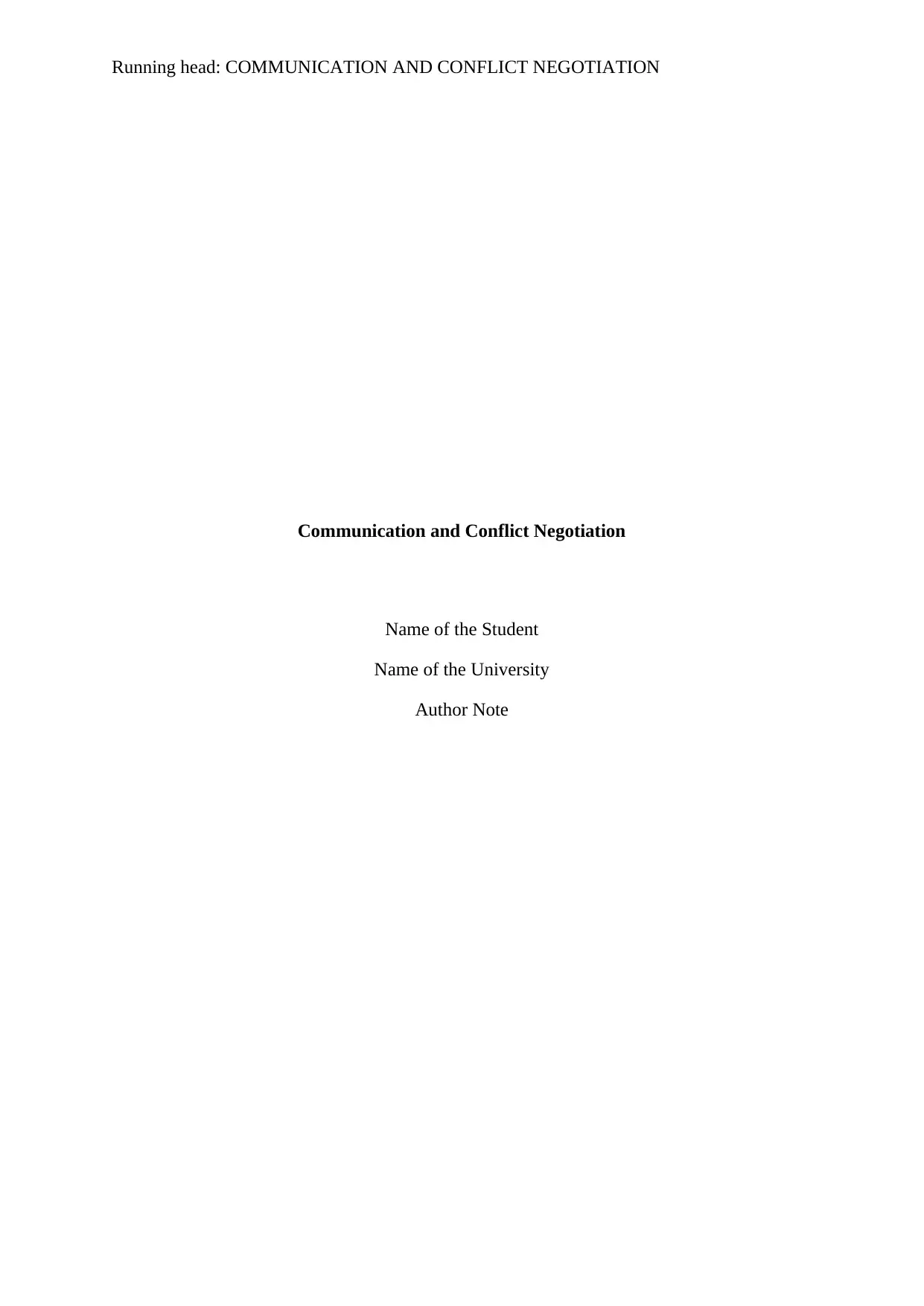
Running head: COMMUNICATION AND CONFLICT NEGOTIATION
Communication and Conflict Negotiation
Name of the Student
Name of the University
Author Note
Communication and Conflict Negotiation
Name of the Student
Name of the University
Author Note
Secure Best Marks with AI Grader
Need help grading? Try our AI Grader for instant feedback on your assignments.

1COMMUNICATION AND CONFLICT NEGOTIATION
Contents
Chapter 1: Developing Self Awareness.....................................................................................2
Identification of the problem:.................................................................................................2
Relevant theories and concepts:.............................................................................................2
Traditional Theory.............................................................................................................2
Avoiding Style of Conflict Management:..........................................................................3
Analysis of the case:...............................................................................................................3
Solutions:................................................................................................................................4
Chapter 3: Solving Problems Analytically and Critically..........................................................5
Identification of the problem:.................................................................................................5
Relevant theories and concepts:.............................................................................................5
Contemporary Theory:.......................................................................................................5
Collaborating Style:...........................................................................................................6
Analysis of the case:...............................................................................................................6
Solutions:................................................................................................................................7
Chapter 7: Managing Conflict....................................................................................................8
Identification of the problem:.................................................................................................8
Relevant theories and concepts:.............................................................................................8
Traditional Theory of Conflict:..........................................................................................8
Competing Style of Conflict Resolution:...........................................................................8
Up-Front Approach to resolve the issue:...........................................................................9
Chapter 10: Leading Positive Change......................................................................................11
Contents
Chapter 1: Developing Self Awareness.....................................................................................2
Identification of the problem:.................................................................................................2
Relevant theories and concepts:.............................................................................................2
Traditional Theory.............................................................................................................2
Avoiding Style of Conflict Management:..........................................................................3
Analysis of the case:...............................................................................................................3
Solutions:................................................................................................................................4
Chapter 3: Solving Problems Analytically and Critically..........................................................5
Identification of the problem:.................................................................................................5
Relevant theories and concepts:.............................................................................................5
Contemporary Theory:.......................................................................................................5
Collaborating Style:...........................................................................................................6
Analysis of the case:...............................................................................................................6
Solutions:................................................................................................................................7
Chapter 7: Managing Conflict....................................................................................................8
Identification of the problem:.................................................................................................8
Relevant theories and concepts:.............................................................................................8
Traditional Theory of Conflict:..........................................................................................8
Competing Style of Conflict Resolution:...........................................................................8
Up-Front Approach to resolve the issue:...........................................................................9
Chapter 10: Leading Positive Change......................................................................................11
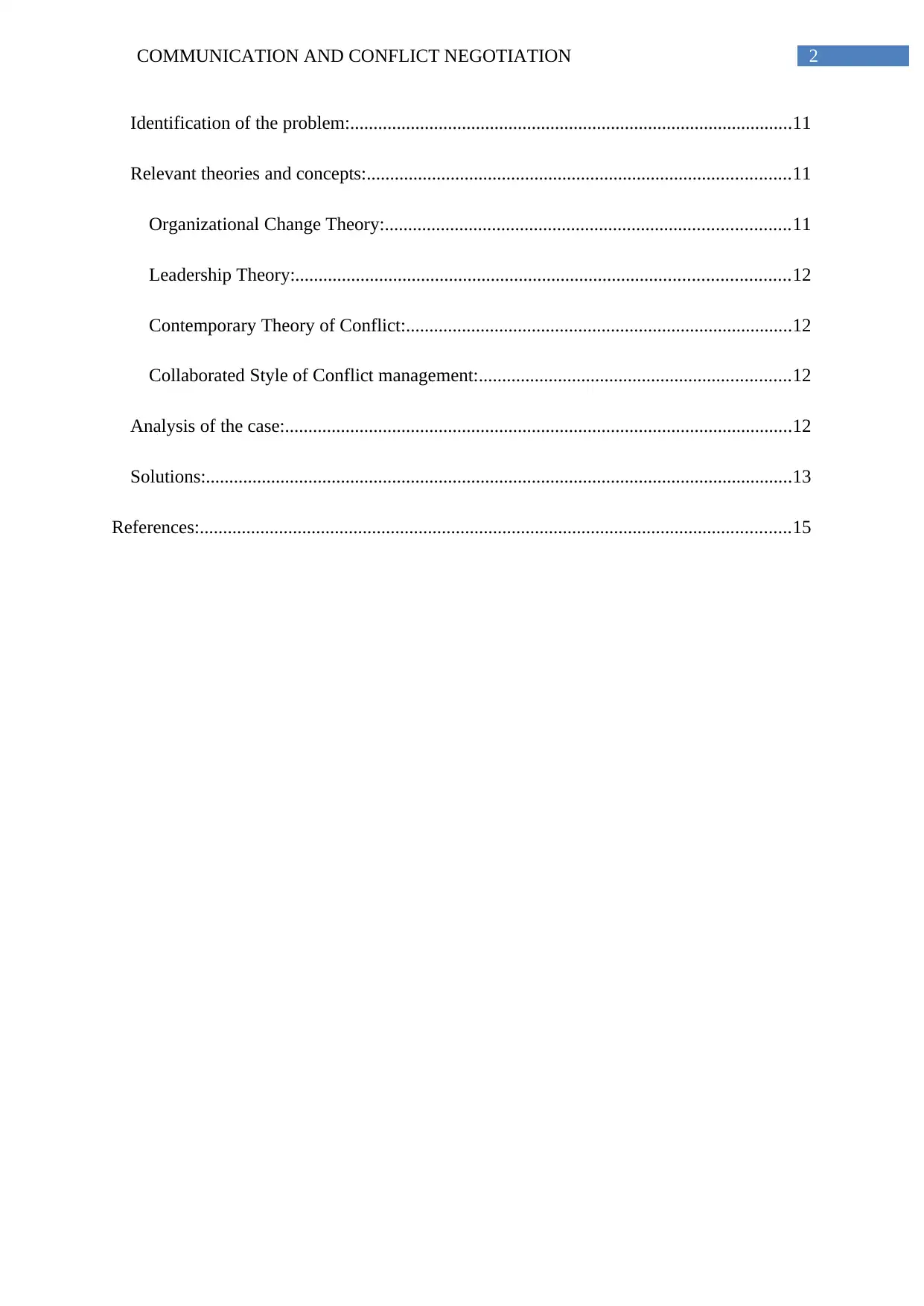
2COMMUNICATION AND CONFLICT NEGOTIATION
Identification of the problem:...............................................................................................11
Relevant theories and concepts:...........................................................................................11
Organizational Change Theory:.......................................................................................11
Leadership Theory:..........................................................................................................12
Contemporary Theory of Conflict:...................................................................................12
Collaborated Style of Conflict management:...................................................................12
Analysis of the case:.............................................................................................................12
Solutions:..............................................................................................................................13
References:...............................................................................................................................15
Identification of the problem:...............................................................................................11
Relevant theories and concepts:...........................................................................................11
Organizational Change Theory:.......................................................................................11
Leadership Theory:..........................................................................................................12
Contemporary Theory of Conflict:...................................................................................12
Collaborated Style of Conflict management:...................................................................12
Analysis of the case:.............................................................................................................12
Solutions:..............................................................................................................................13
References:...............................................................................................................................15
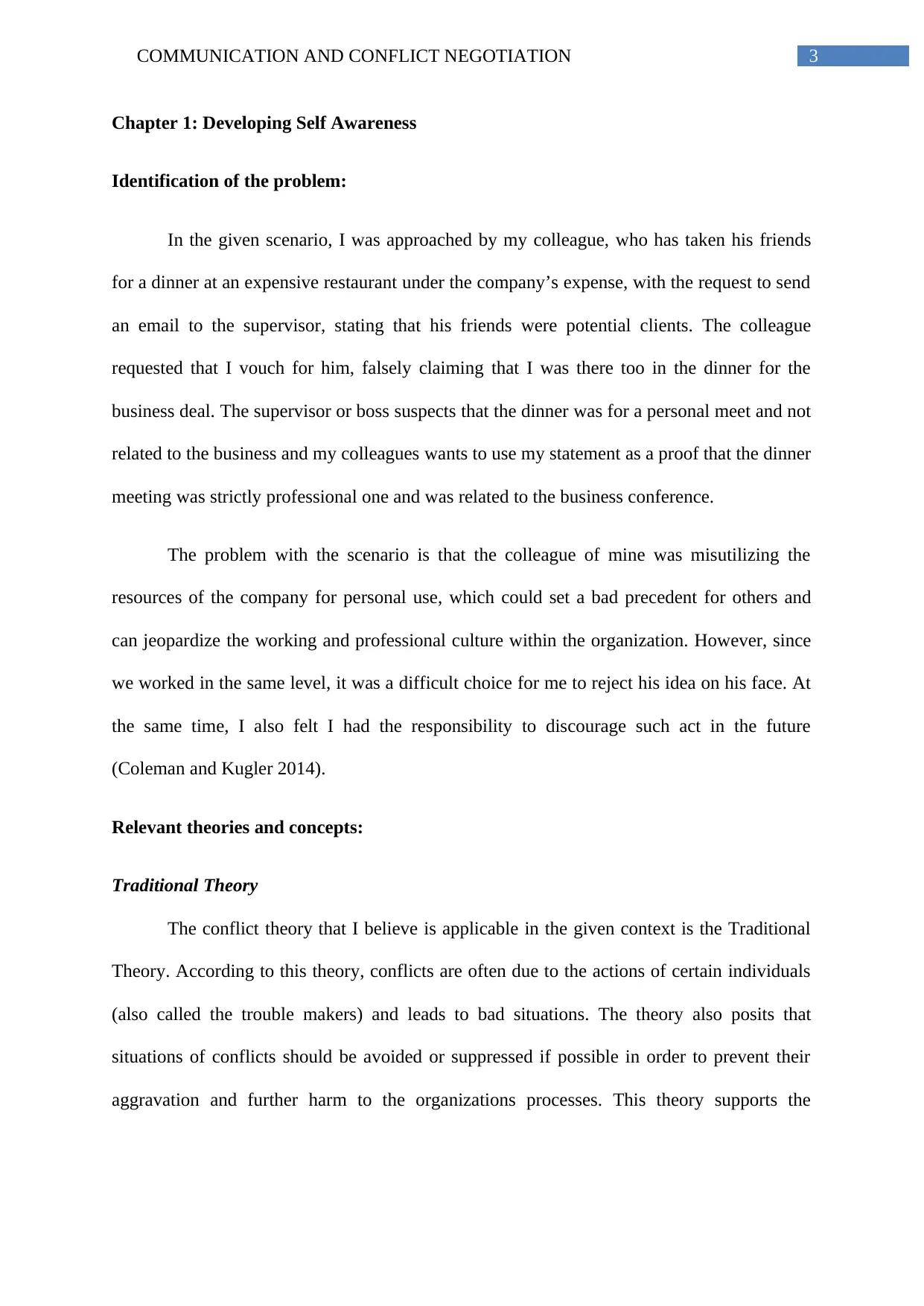
3COMMUNICATION AND CONFLICT NEGOTIATION
Chapter 1: Developing Self Awareness
Identification of the problem:
In the given scenario, I was approached by my colleague, who has taken his friends
for a dinner at an expensive restaurant under the company’s expense, with the request to send
an email to the supervisor, stating that his friends were potential clients. The colleague
requested that I vouch for him, falsely claiming that I was there too in the dinner for the
business deal. The supervisor or boss suspects that the dinner was for a personal meet and not
related to the business and my colleagues wants to use my statement as a proof that the dinner
meeting was strictly professional one and was related to the business conference.
The problem with the scenario is that the colleague of mine was misutilizing the
resources of the company for personal use, which could set a bad precedent for others and
can jeopardize the working and professional culture within the organization. However, since
we worked in the same level, it was a difficult choice for me to reject his idea on his face. At
the same time, I also felt I had the responsibility to discourage such act in the future
(Coleman and Kugler 2014).
Relevant theories and concepts:
Traditional Theory
The conflict theory that I believe is applicable in the given context is the Traditional
Theory. According to this theory, conflicts are often due to the actions of certain individuals
(also called the trouble makers) and leads to bad situations. The theory also posits that
situations of conflicts should be avoided or suppressed if possible in order to prevent their
aggravation and further harm to the organizations processes. This theory supports the
Chapter 1: Developing Self Awareness
Identification of the problem:
In the given scenario, I was approached by my colleague, who has taken his friends
for a dinner at an expensive restaurant under the company’s expense, with the request to send
an email to the supervisor, stating that his friends were potential clients. The colleague
requested that I vouch for him, falsely claiming that I was there too in the dinner for the
business deal. The supervisor or boss suspects that the dinner was for a personal meet and not
related to the business and my colleagues wants to use my statement as a proof that the dinner
meeting was strictly professional one and was related to the business conference.
The problem with the scenario is that the colleague of mine was misutilizing the
resources of the company for personal use, which could set a bad precedent for others and
can jeopardize the working and professional culture within the organization. However, since
we worked in the same level, it was a difficult choice for me to reject his idea on his face. At
the same time, I also felt I had the responsibility to discourage such act in the future
(Coleman and Kugler 2014).
Relevant theories and concepts:
Traditional Theory
The conflict theory that I believe is applicable in the given context is the Traditional
Theory. According to this theory, conflicts are often due to the actions of certain individuals
(also called the trouble makers) and leads to bad situations. The theory also posits that
situations of conflicts should be avoided or suppressed if possible in order to prevent their
aggravation and further harm to the organizations processes. This theory supports the
Secure Best Marks with AI Grader
Need help grading? Try our AI Grader for instant feedback on your assignments.

4COMMUNICATION AND CONFLICT NEGOTIATION
argument that there can be troublemakers in any environment and that their behavior needs to
be managed to ensure a good working culture (Avruch 2018).
Avoiding Style of Conflict Management:
According to this theory of conflict management, potential conflicting situation can be
mitigated to some extent through avoiding it. This theory supports that by not helping the
individuals responsible for creating the conflict, it is possible to dissuade them from such
actions, as well as help to mitigate conflicts. However, this theory is mostly applicable for
trivial conflicts or conflicts that can be costly for the organization. The avoidance of the
conflict situation implies low levels of assertiveness as well as low levels of cooperation.
Thus it allows individuals to neither assist the individual to reach their objectives nor assert
authority over them to rectify their mistakes (Zhang et al. 2015).
Analysis of the case:
In my opinion, the conflict in this situation arises from the perspective of ethics, more
specifically, work ethics. According to Kohlberg’s stages of moral development, an ethical
principle is the last of seventh level of morals at the third level of morality (Post-
Conventional). Reaching the Post-Conventional level, an individual develops understanding
as well as responsibility towards the maintenance of ethical principles. This level fosters the
development of a principled conscience, or a conscience that is developed on strong ethical
and moral principles. Individuals with such sense of conscience would not partake in
unethical work, and help to maintain the ethical values that are universally applicable (that is
identifying what is wrong and what is right) (Krebs et al. 2014).
My own orientation is also to maintain my code of ethical principles, and not engage
in any activities that I feel as not being ethical or being coerced into the same. I believe that
in a large organization, a huge diversity exists among the mindsets of people, each having
argument that there can be troublemakers in any environment and that their behavior needs to
be managed to ensure a good working culture (Avruch 2018).
Avoiding Style of Conflict Management:
According to this theory of conflict management, potential conflicting situation can be
mitigated to some extent through avoiding it. This theory supports that by not helping the
individuals responsible for creating the conflict, it is possible to dissuade them from such
actions, as well as help to mitigate conflicts. However, this theory is mostly applicable for
trivial conflicts or conflicts that can be costly for the organization. The avoidance of the
conflict situation implies low levels of assertiveness as well as low levels of cooperation.
Thus it allows individuals to neither assist the individual to reach their objectives nor assert
authority over them to rectify their mistakes (Zhang et al. 2015).
Analysis of the case:
In my opinion, the conflict in this situation arises from the perspective of ethics, more
specifically, work ethics. According to Kohlberg’s stages of moral development, an ethical
principle is the last of seventh level of morals at the third level of morality (Post-
Conventional). Reaching the Post-Conventional level, an individual develops understanding
as well as responsibility towards the maintenance of ethical principles. This level fosters the
development of a principled conscience, or a conscience that is developed on strong ethical
and moral principles. Individuals with such sense of conscience would not partake in
unethical work, and help to maintain the ethical values that are universally applicable (that is
identifying what is wrong and what is right) (Krebs et al. 2014).
My own orientation is also to maintain my code of ethical principles, and not engage
in any activities that I feel as not being ethical or being coerced into the same. I believe that
in a large organization, a huge diversity exists among the mindsets of people, each having
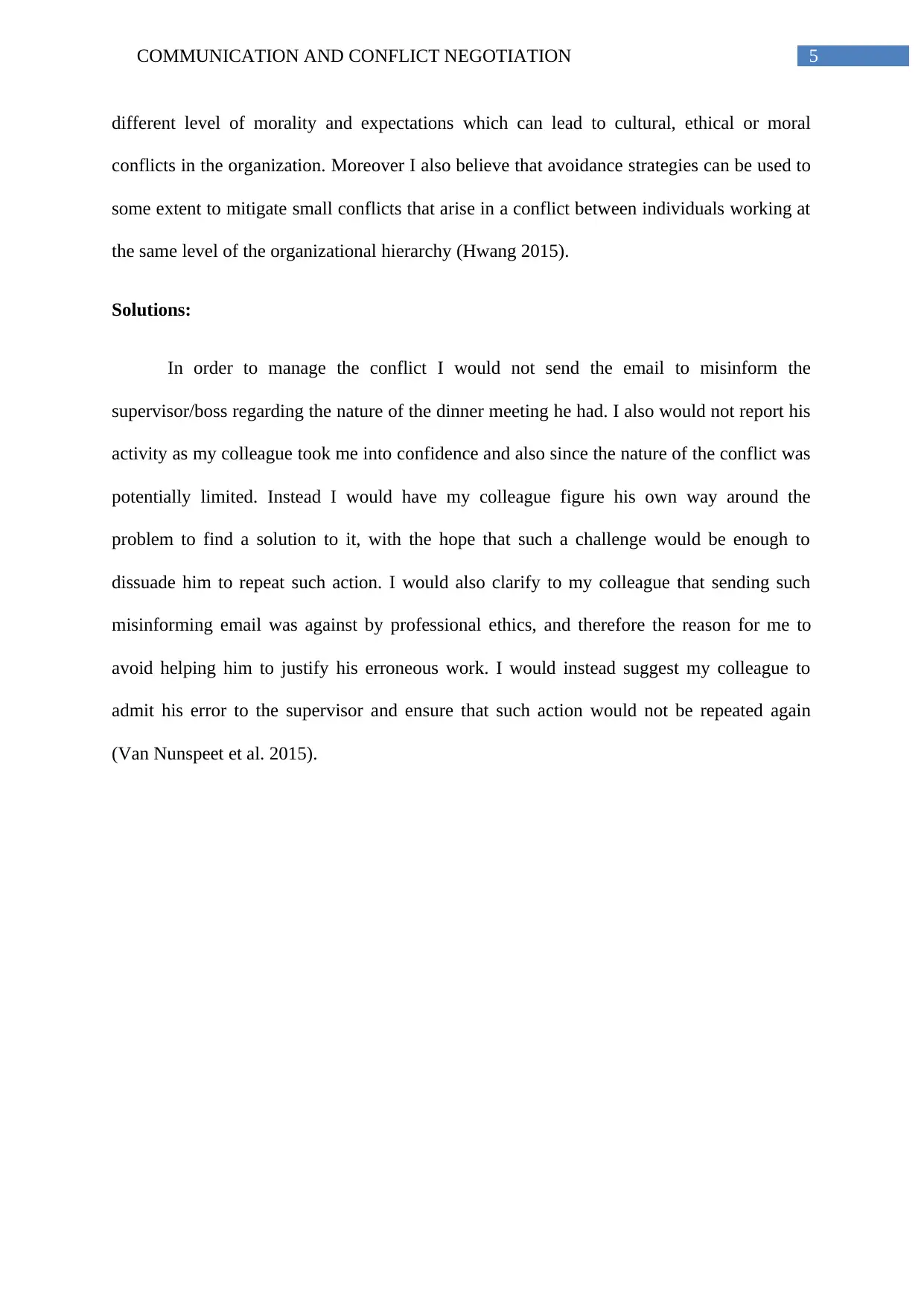
5COMMUNICATION AND CONFLICT NEGOTIATION
different level of morality and expectations which can lead to cultural, ethical or moral
conflicts in the organization. Moreover I also believe that avoidance strategies can be used to
some extent to mitigate small conflicts that arise in a conflict between individuals working at
the same level of the organizational hierarchy (Hwang 2015).
Solutions:
In order to manage the conflict I would not send the email to misinform the
supervisor/boss regarding the nature of the dinner meeting he had. I also would not report his
activity as my colleague took me into confidence and also since the nature of the conflict was
potentially limited. Instead I would have my colleague figure his own way around the
problem to find a solution to it, with the hope that such a challenge would be enough to
dissuade him to repeat such action. I would also clarify to my colleague that sending such
misinforming email was against by professional ethics, and therefore the reason for me to
avoid helping him to justify his erroneous work. I would instead suggest my colleague to
admit his error to the supervisor and ensure that such action would not be repeated again
(Van Nunspeet et al. 2015).
different level of morality and expectations which can lead to cultural, ethical or moral
conflicts in the organization. Moreover I also believe that avoidance strategies can be used to
some extent to mitigate small conflicts that arise in a conflict between individuals working at
the same level of the organizational hierarchy (Hwang 2015).
Solutions:
In order to manage the conflict I would not send the email to misinform the
supervisor/boss regarding the nature of the dinner meeting he had. I also would not report his
activity as my colleague took me into confidence and also since the nature of the conflict was
potentially limited. Instead I would have my colleague figure his own way around the
problem to find a solution to it, with the hope that such a challenge would be enough to
dissuade him to repeat such action. I would also clarify to my colleague that sending such
misinforming email was against by professional ethics, and therefore the reason for me to
avoid helping him to justify his erroneous work. I would instead suggest my colleague to
admit his error to the supervisor and ensure that such action would not be repeated again
(Van Nunspeet et al. 2015).
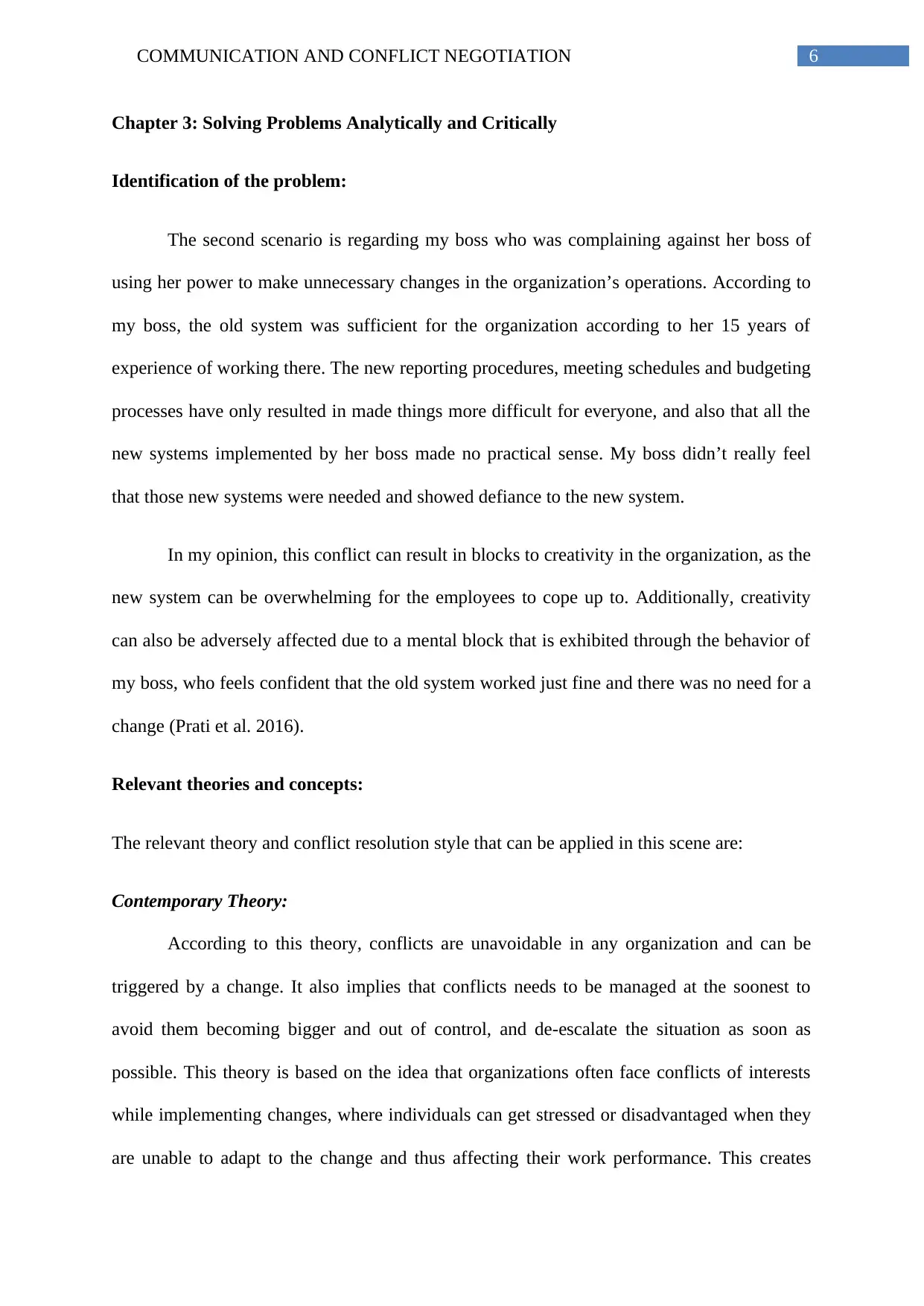
6COMMUNICATION AND CONFLICT NEGOTIATION
Chapter 3: Solving Problems Analytically and Critically
Identification of the problem:
The second scenario is regarding my boss who was complaining against her boss of
using her power to make unnecessary changes in the organization’s operations. According to
my boss, the old system was sufficient for the organization according to her 15 years of
experience of working there. The new reporting procedures, meeting schedules and budgeting
processes have only resulted in made things more difficult for everyone, and also that all the
new systems implemented by her boss made no practical sense. My boss didn’t really feel
that those new systems were needed and showed defiance to the new system.
In my opinion, this conflict can result in blocks to creativity in the organization, as the
new system can be overwhelming for the employees to cope up to. Additionally, creativity
can also be adversely affected due to a mental block that is exhibited through the behavior of
my boss, who feels confident that the old system worked just fine and there was no need for a
change (Prati et al. 2016).
Relevant theories and concepts:
The relevant theory and conflict resolution style that can be applied in this scene are:
Contemporary Theory:
According to this theory, conflicts are unavoidable in any organization and can be
triggered by a change. It also implies that conflicts needs to be managed at the soonest to
avoid them becoming bigger and out of control, and de-escalate the situation as soon as
possible. This theory is based on the idea that organizations often face conflicts of interests
while implementing changes, where individuals can get stressed or disadvantaged when they
are unable to adapt to the change and thus affecting their work performance. This creates
Chapter 3: Solving Problems Analytically and Critically
Identification of the problem:
The second scenario is regarding my boss who was complaining against her boss of
using her power to make unnecessary changes in the organization’s operations. According to
my boss, the old system was sufficient for the organization according to her 15 years of
experience of working there. The new reporting procedures, meeting schedules and budgeting
processes have only resulted in made things more difficult for everyone, and also that all the
new systems implemented by her boss made no practical sense. My boss didn’t really feel
that those new systems were needed and showed defiance to the new system.
In my opinion, this conflict can result in blocks to creativity in the organization, as the
new system can be overwhelming for the employees to cope up to. Additionally, creativity
can also be adversely affected due to a mental block that is exhibited through the behavior of
my boss, who feels confident that the old system worked just fine and there was no need for a
change (Prati et al. 2016).
Relevant theories and concepts:
The relevant theory and conflict resolution style that can be applied in this scene are:
Contemporary Theory:
According to this theory, conflicts are unavoidable in any organization and can be
triggered by a change. It also implies that conflicts needs to be managed at the soonest to
avoid them becoming bigger and out of control, and de-escalate the situation as soon as
possible. This theory is based on the idea that organizations often face conflicts of interests
while implementing changes, where individuals can get stressed or disadvantaged when they
are unable to adapt to the change and thus affecting their work performance. This creates
Paraphrase This Document
Need a fresh take? Get an instant paraphrase of this document with our AI Paraphraser
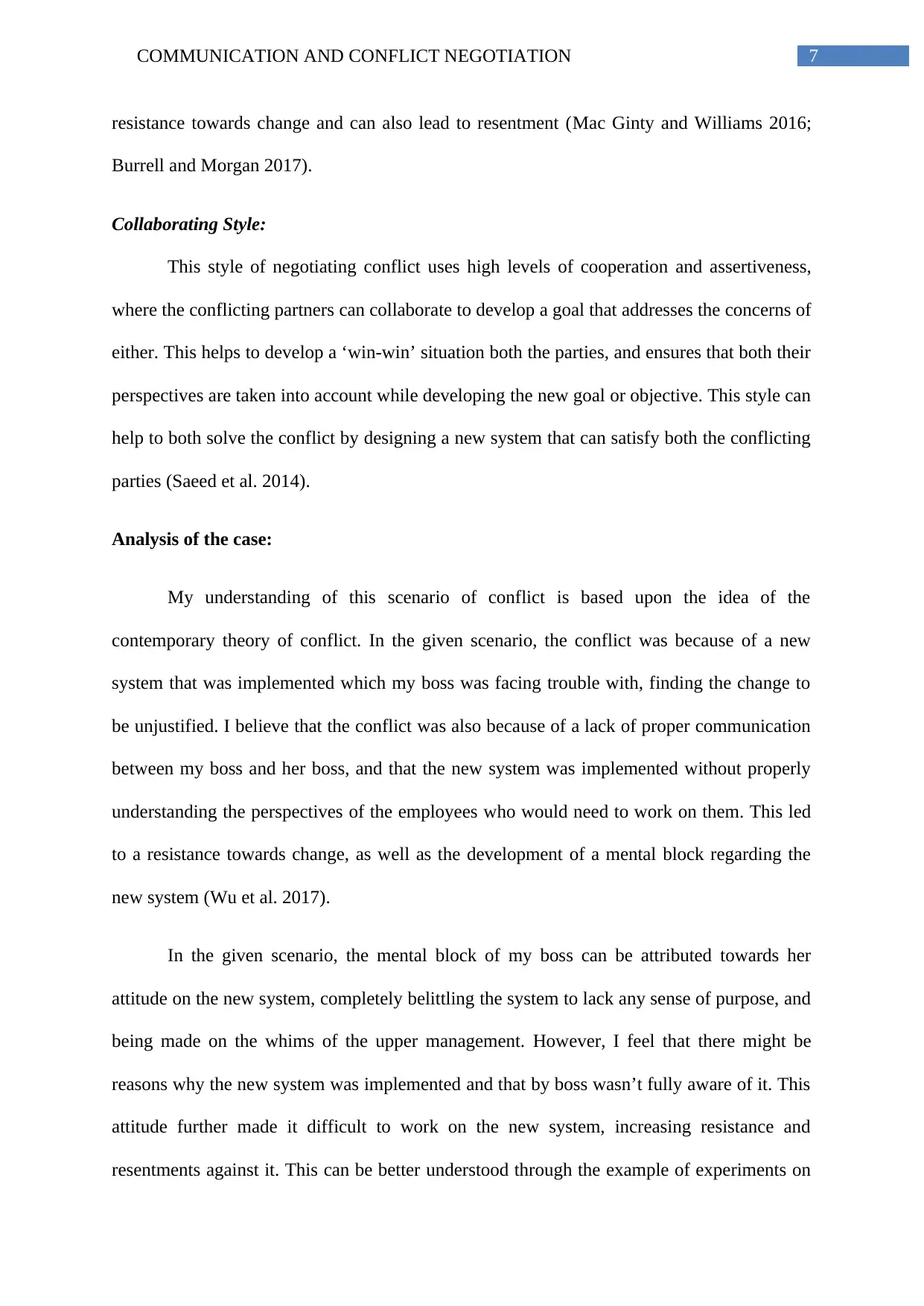
7COMMUNICATION AND CONFLICT NEGOTIATION
resistance towards change and can also lead to resentment (Mac Ginty and Williams 2016;
Burrell and Morgan 2017).
Collaborating Style:
This style of negotiating conflict uses high levels of cooperation and assertiveness,
where the conflicting partners can collaborate to develop a goal that addresses the concerns of
either. This helps to develop a ‘win-win’ situation both the parties, and ensures that both their
perspectives are taken into account while developing the new goal or objective. This style can
help to both solve the conflict by designing a new system that can satisfy both the conflicting
parties (Saeed et al. 2014).
Analysis of the case:
My understanding of this scenario of conflict is based upon the idea of the
contemporary theory of conflict. In the given scenario, the conflict was because of a new
system that was implemented which my boss was facing trouble with, finding the change to
be unjustified. I believe that the conflict was also because of a lack of proper communication
between my boss and her boss, and that the new system was implemented without properly
understanding the perspectives of the employees who would need to work on them. This led
to a resistance towards change, as well as the development of a mental block regarding the
new system (Wu et al. 2017).
In the given scenario, the mental block of my boss can be attributed towards her
attitude on the new system, completely belittling the system to lack any sense of purpose, and
being made on the whims of the upper management. However, I feel that there might be
reasons why the new system was implemented and that by boss wasn’t fully aware of it. This
attitude further made it difficult to work on the new system, increasing resistance and
resentments against it. This can be better understood through the example of experiments on
resistance towards change and can also lead to resentment (Mac Ginty and Williams 2016;
Burrell and Morgan 2017).
Collaborating Style:
This style of negotiating conflict uses high levels of cooperation and assertiveness,
where the conflicting partners can collaborate to develop a goal that addresses the concerns of
either. This helps to develop a ‘win-win’ situation both the parties, and ensures that both their
perspectives are taken into account while developing the new goal or objective. This style can
help to both solve the conflict by designing a new system that can satisfy both the conflicting
parties (Saeed et al. 2014).
Analysis of the case:
My understanding of this scenario of conflict is based upon the idea of the
contemporary theory of conflict. In the given scenario, the conflict was because of a new
system that was implemented which my boss was facing trouble with, finding the change to
be unjustified. I believe that the conflict was also because of a lack of proper communication
between my boss and her boss, and that the new system was implemented without properly
understanding the perspectives of the employees who would need to work on them. This led
to a resistance towards change, as well as the development of a mental block regarding the
new system (Wu et al. 2017).
In the given scenario, the mental block of my boss can be attributed towards her
attitude on the new system, completely belittling the system to lack any sense of purpose, and
being made on the whims of the upper management. However, I feel that there might be
reasons why the new system was implemented and that by boss wasn’t fully aware of it. This
attitude further made it difficult to work on the new system, increasing resistance and
resentments against it. This can be better understood through the example of experiments on
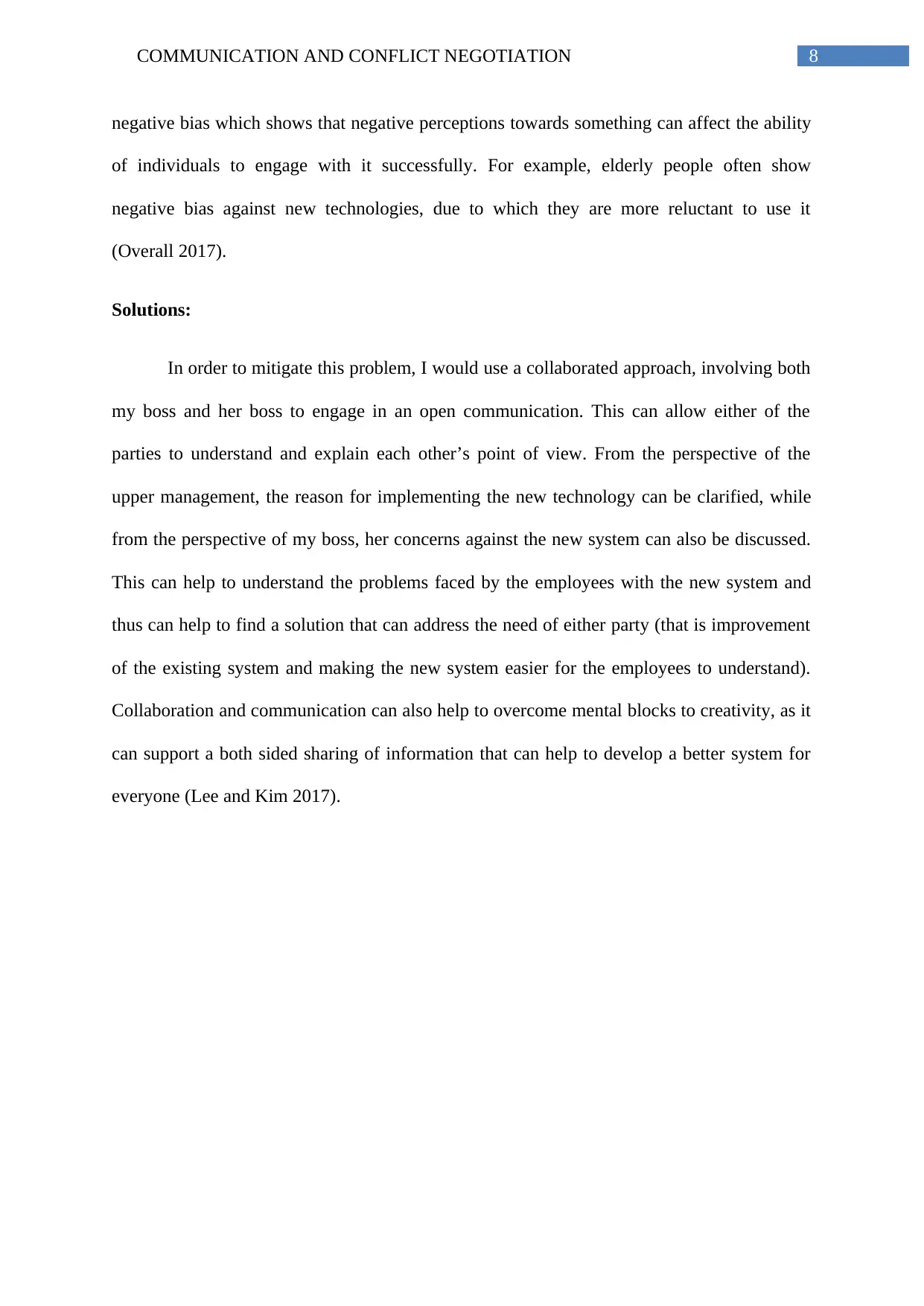
8COMMUNICATION AND CONFLICT NEGOTIATION
negative bias which shows that negative perceptions towards something can affect the ability
of individuals to engage with it successfully. For example, elderly people often show
negative bias against new technologies, due to which they are more reluctant to use it
(Overall 2017).
Solutions:
In order to mitigate this problem, I would use a collaborated approach, involving both
my boss and her boss to engage in an open communication. This can allow either of the
parties to understand and explain each other’s point of view. From the perspective of the
upper management, the reason for implementing the new technology can be clarified, while
from the perspective of my boss, her concerns against the new system can also be discussed.
This can help to understand the problems faced by the employees with the new system and
thus can help to find a solution that can address the need of either party (that is improvement
of the existing system and making the new system easier for the employees to understand).
Collaboration and communication can also help to overcome mental blocks to creativity, as it
can support a both sided sharing of information that can help to develop a better system for
everyone (Lee and Kim 2017).
negative bias which shows that negative perceptions towards something can affect the ability
of individuals to engage with it successfully. For example, elderly people often show
negative bias against new technologies, due to which they are more reluctant to use it
(Overall 2017).
Solutions:
In order to mitigate this problem, I would use a collaborated approach, involving both
my boss and her boss to engage in an open communication. This can allow either of the
parties to understand and explain each other’s point of view. From the perspective of the
upper management, the reason for implementing the new technology can be clarified, while
from the perspective of my boss, her concerns against the new system can also be discussed.
This can help to understand the problems faced by the employees with the new system and
thus can help to find a solution that can address the need of either party (that is improvement
of the existing system and making the new system easier for the employees to understand).
Collaboration and communication can also help to overcome mental blocks to creativity, as it
can support a both sided sharing of information that can help to develop a better system for
everyone (Lee and Kim 2017).
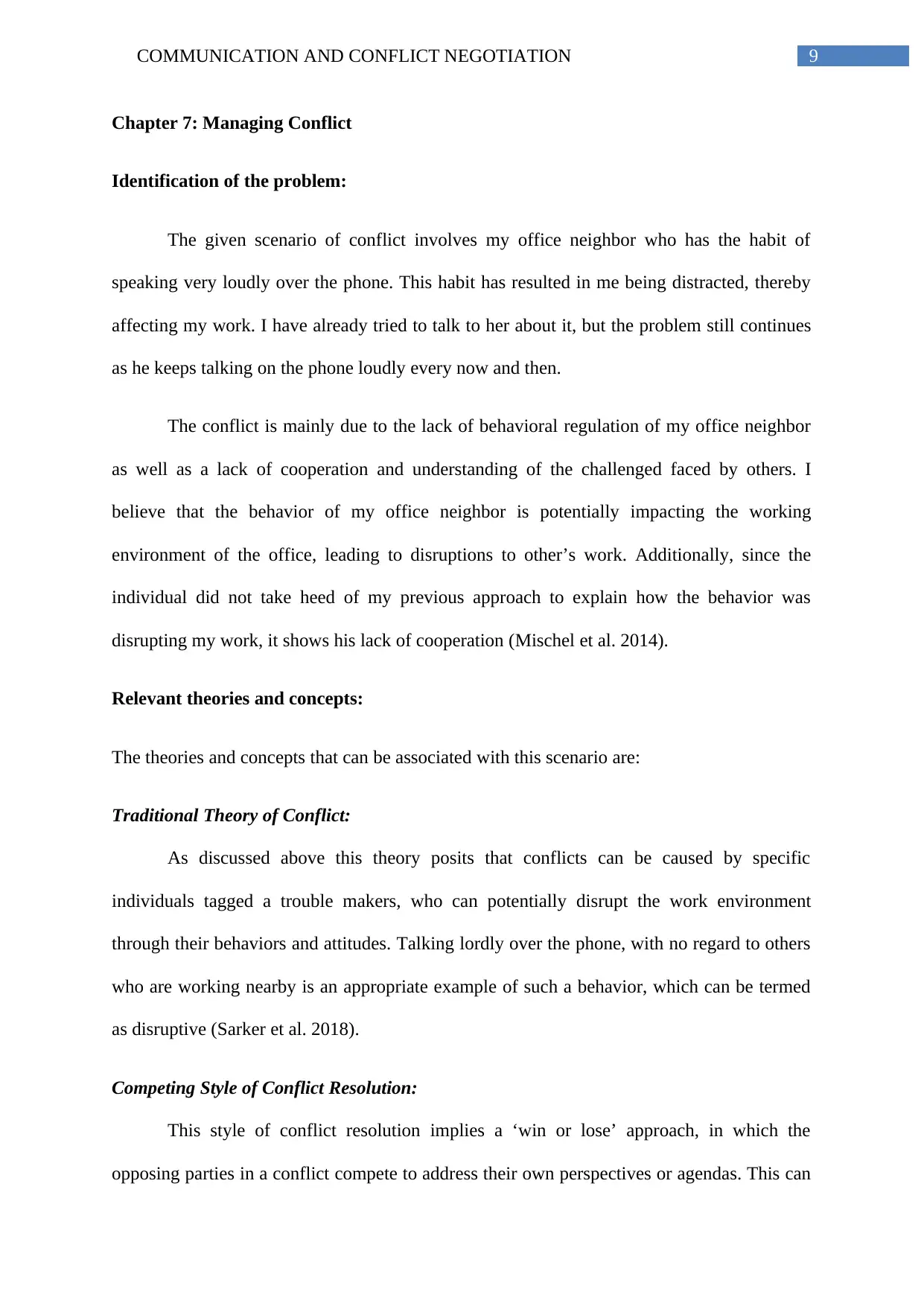
9COMMUNICATION AND CONFLICT NEGOTIATION
Chapter 7: Managing Conflict
Identification of the problem:
The given scenario of conflict involves my office neighbor who has the habit of
speaking very loudly over the phone. This habit has resulted in me being distracted, thereby
affecting my work. I have already tried to talk to her about it, but the problem still continues
as he keeps talking on the phone loudly every now and then.
The conflict is mainly due to the lack of behavioral regulation of my office neighbor
as well as a lack of cooperation and understanding of the challenged faced by others. I
believe that the behavior of my office neighbor is potentially impacting the working
environment of the office, leading to disruptions to other’s work. Additionally, since the
individual did not take heed of my previous approach to explain how the behavior was
disrupting my work, it shows his lack of cooperation (Mischel et al. 2014).
Relevant theories and concepts:
The theories and concepts that can be associated with this scenario are:
Traditional Theory of Conflict:
As discussed above this theory posits that conflicts can be caused by specific
individuals tagged a trouble makers, who can potentially disrupt the work environment
through their behaviors and attitudes. Talking lordly over the phone, with no regard to others
who are working nearby is an appropriate example of such a behavior, which can be termed
as disruptive (Sarker et al. 2018).
Competing Style of Conflict Resolution:
This style of conflict resolution implies a ‘win or lose’ approach, in which the
opposing parties in a conflict compete to address their own perspectives or agendas. This can
Chapter 7: Managing Conflict
Identification of the problem:
The given scenario of conflict involves my office neighbor who has the habit of
speaking very loudly over the phone. This habit has resulted in me being distracted, thereby
affecting my work. I have already tried to talk to her about it, but the problem still continues
as he keeps talking on the phone loudly every now and then.
The conflict is mainly due to the lack of behavioral regulation of my office neighbor
as well as a lack of cooperation and understanding of the challenged faced by others. I
believe that the behavior of my office neighbor is potentially impacting the working
environment of the office, leading to disruptions to other’s work. Additionally, since the
individual did not take heed of my previous approach to explain how the behavior was
disrupting my work, it shows his lack of cooperation (Mischel et al. 2014).
Relevant theories and concepts:
The theories and concepts that can be associated with this scenario are:
Traditional Theory of Conflict:
As discussed above this theory posits that conflicts can be caused by specific
individuals tagged a trouble makers, who can potentially disrupt the work environment
through their behaviors and attitudes. Talking lordly over the phone, with no regard to others
who are working nearby is an appropriate example of such a behavior, which can be termed
as disruptive (Sarker et al. 2018).
Competing Style of Conflict Resolution:
This style of conflict resolution implies a ‘win or lose’ approach, in which the
opposing parties in a conflict compete to address their own perspectives or agendas. This can
Secure Best Marks with AI Grader
Need help grading? Try our AI Grader for instant feedback on your assignments.
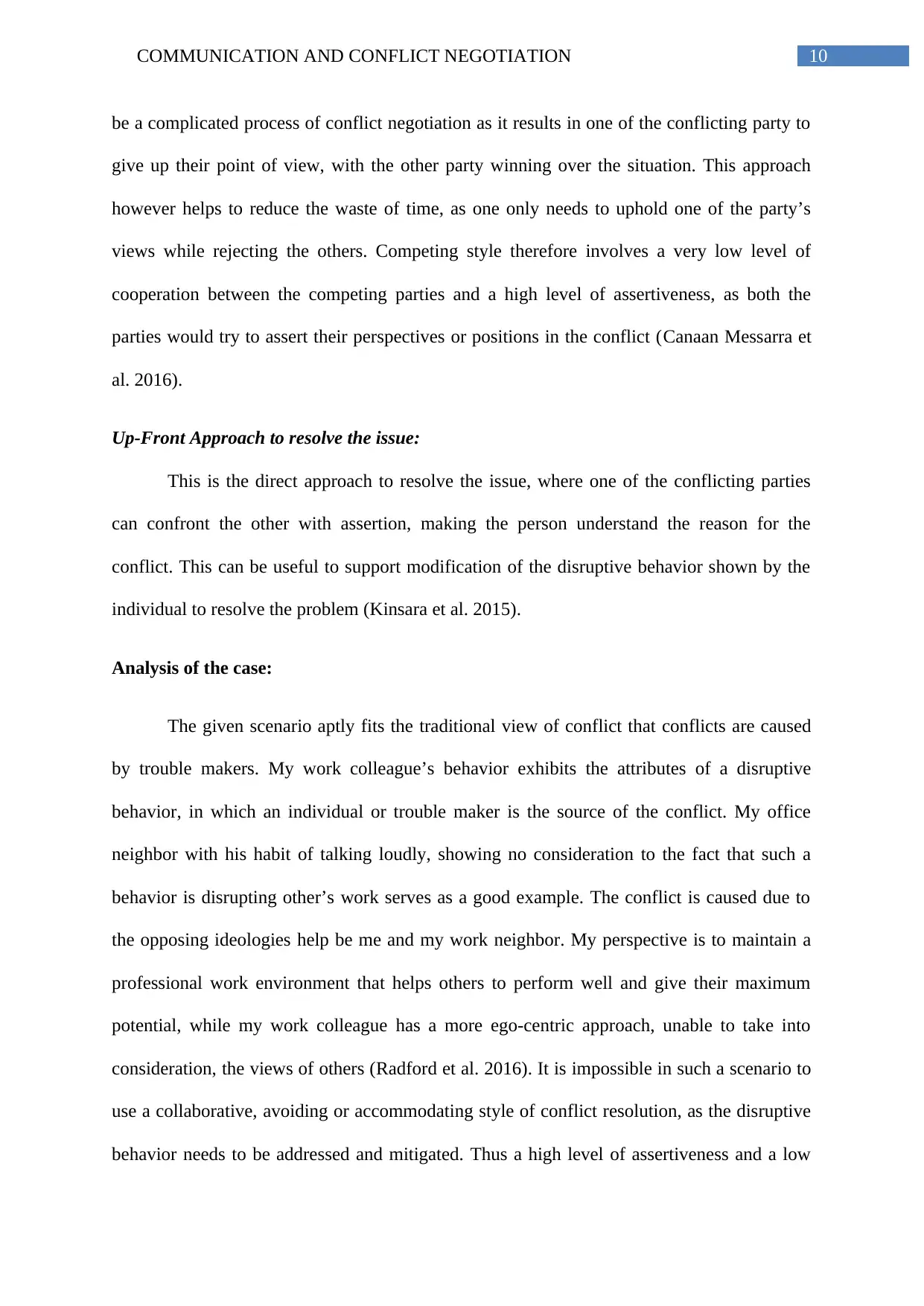
10COMMUNICATION AND CONFLICT NEGOTIATION
be a complicated process of conflict negotiation as it results in one of the conflicting party to
give up their point of view, with the other party winning over the situation. This approach
however helps to reduce the waste of time, as one only needs to uphold one of the party’s
views while rejecting the others. Competing style therefore involves a very low level of
cooperation between the competing parties and a high level of assertiveness, as both the
parties would try to assert their perspectives or positions in the conflict (Canaan Messarra et
al. 2016).
Up-Front Approach to resolve the issue:
This is the direct approach to resolve the issue, where one of the conflicting parties
can confront the other with assertion, making the person understand the reason for the
conflict. This can be useful to support modification of the disruptive behavior shown by the
individual to resolve the problem (Kinsara et al. 2015).
Analysis of the case:
The given scenario aptly fits the traditional view of conflict that conflicts are caused
by trouble makers. My work colleague’s behavior exhibits the attributes of a disruptive
behavior, in which an individual or trouble maker is the source of the conflict. My office
neighbor with his habit of talking loudly, showing no consideration to the fact that such a
behavior is disrupting other’s work serves as a good example. The conflict is caused due to
the opposing ideologies help be me and my work neighbor. My perspective is to maintain a
professional work environment that helps others to perform well and give their maximum
potential, while my work colleague has a more ego-centric approach, unable to take into
consideration, the views of others (Radford et al. 2016). It is impossible in such a scenario to
use a collaborative, avoiding or accommodating style of conflict resolution, as the disruptive
behavior needs to be addressed and mitigated. Thus a high level of assertiveness and a low
be a complicated process of conflict negotiation as it results in one of the conflicting party to
give up their point of view, with the other party winning over the situation. This approach
however helps to reduce the waste of time, as one only needs to uphold one of the party’s
views while rejecting the others. Competing style therefore involves a very low level of
cooperation between the competing parties and a high level of assertiveness, as both the
parties would try to assert their perspectives or positions in the conflict (Canaan Messarra et
al. 2016).
Up-Front Approach to resolve the issue:
This is the direct approach to resolve the issue, where one of the conflicting parties
can confront the other with assertion, making the person understand the reason for the
conflict. This can be useful to support modification of the disruptive behavior shown by the
individual to resolve the problem (Kinsara et al. 2015).
Analysis of the case:
The given scenario aptly fits the traditional view of conflict that conflicts are caused
by trouble makers. My work colleague’s behavior exhibits the attributes of a disruptive
behavior, in which an individual or trouble maker is the source of the conflict. My office
neighbor with his habit of talking loudly, showing no consideration to the fact that such a
behavior is disrupting other’s work serves as a good example. The conflict is caused due to
the opposing ideologies help be me and my work neighbor. My perspective is to maintain a
professional work environment that helps others to perform well and give their maximum
potential, while my work colleague has a more ego-centric approach, unable to take into
consideration, the views of others (Radford et al. 2016). It is impossible in such a scenario to
use a collaborative, avoiding or accommodating style of conflict resolution, as the disruptive
behavior needs to be addressed and mitigated. Thus a high level of assertiveness and a low
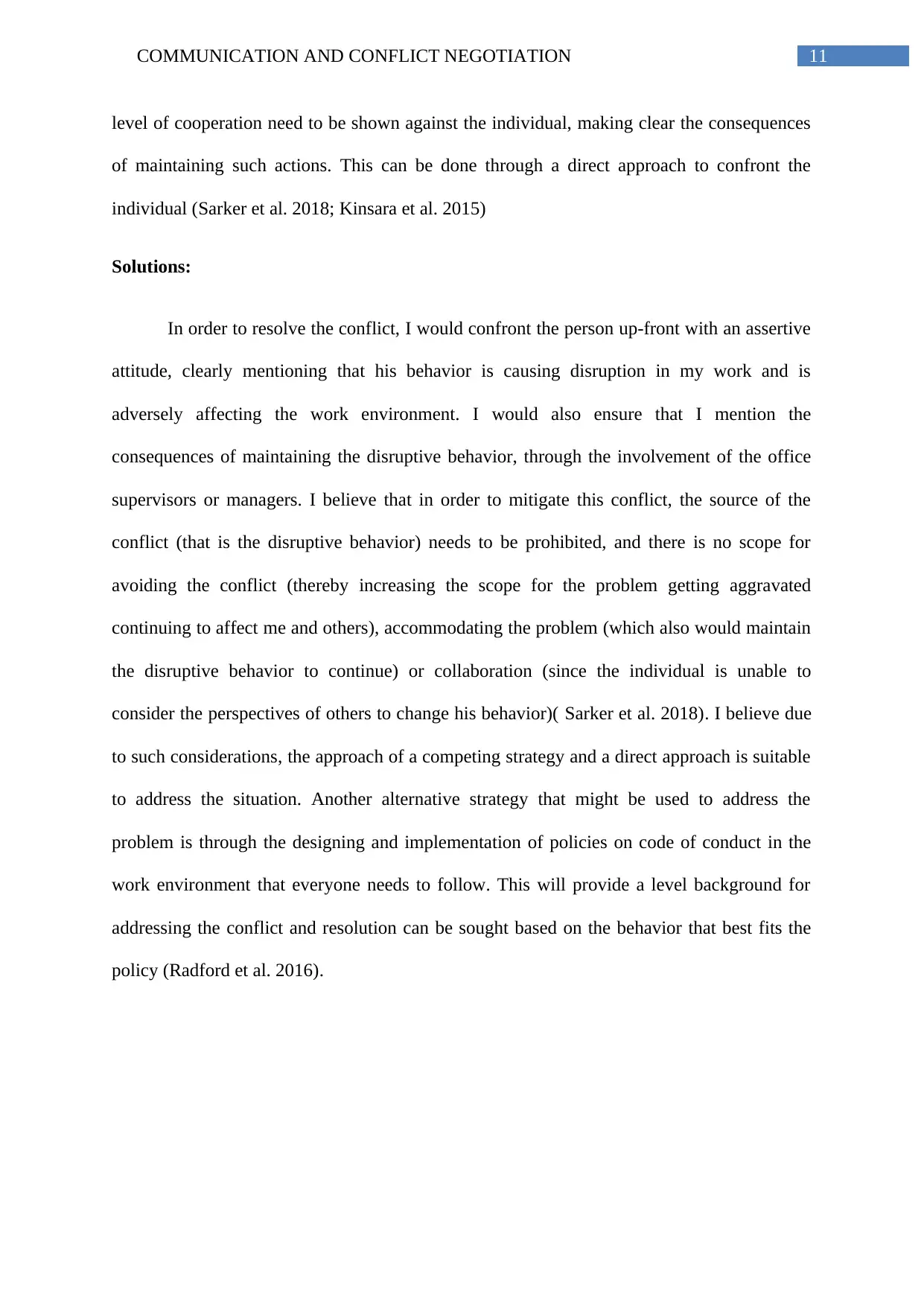
11COMMUNICATION AND CONFLICT NEGOTIATION
level of cooperation need to be shown against the individual, making clear the consequences
of maintaining such actions. This can be done through a direct approach to confront the
individual (Sarker et al. 2018; Kinsara et al. 2015)
Solutions:
In order to resolve the conflict, I would confront the person up-front with an assertive
attitude, clearly mentioning that his behavior is causing disruption in my work and is
adversely affecting the work environment. I would also ensure that I mention the
consequences of maintaining the disruptive behavior, through the involvement of the office
supervisors or managers. I believe that in order to mitigate this conflict, the source of the
conflict (that is the disruptive behavior) needs to be prohibited, and there is no scope for
avoiding the conflict (thereby increasing the scope for the problem getting aggravated
continuing to affect me and others), accommodating the problem (which also would maintain
the disruptive behavior to continue) or collaboration (since the individual is unable to
consider the perspectives of others to change his behavior)( Sarker et al. 2018). I believe due
to such considerations, the approach of a competing strategy and a direct approach is suitable
to address the situation. Another alternative strategy that might be used to address the
problem is through the designing and implementation of policies on code of conduct in the
work environment that everyone needs to follow. This will provide a level background for
addressing the conflict and resolution can be sought based on the behavior that best fits the
policy (Radford et al. 2016).
level of cooperation need to be shown against the individual, making clear the consequences
of maintaining such actions. This can be done through a direct approach to confront the
individual (Sarker et al. 2018; Kinsara et al. 2015)
Solutions:
In order to resolve the conflict, I would confront the person up-front with an assertive
attitude, clearly mentioning that his behavior is causing disruption in my work and is
adversely affecting the work environment. I would also ensure that I mention the
consequences of maintaining the disruptive behavior, through the involvement of the office
supervisors or managers. I believe that in order to mitigate this conflict, the source of the
conflict (that is the disruptive behavior) needs to be prohibited, and there is no scope for
avoiding the conflict (thereby increasing the scope for the problem getting aggravated
continuing to affect me and others), accommodating the problem (which also would maintain
the disruptive behavior to continue) or collaboration (since the individual is unable to
consider the perspectives of others to change his behavior)( Sarker et al. 2018). I believe due
to such considerations, the approach of a competing strategy and a direct approach is suitable
to address the situation. Another alternative strategy that might be used to address the
problem is through the designing and implementation of policies on code of conduct in the
work environment that everyone needs to follow. This will provide a level background for
addressing the conflict and resolution can be sought based on the behavior that best fits the
policy (Radford et al. 2016).
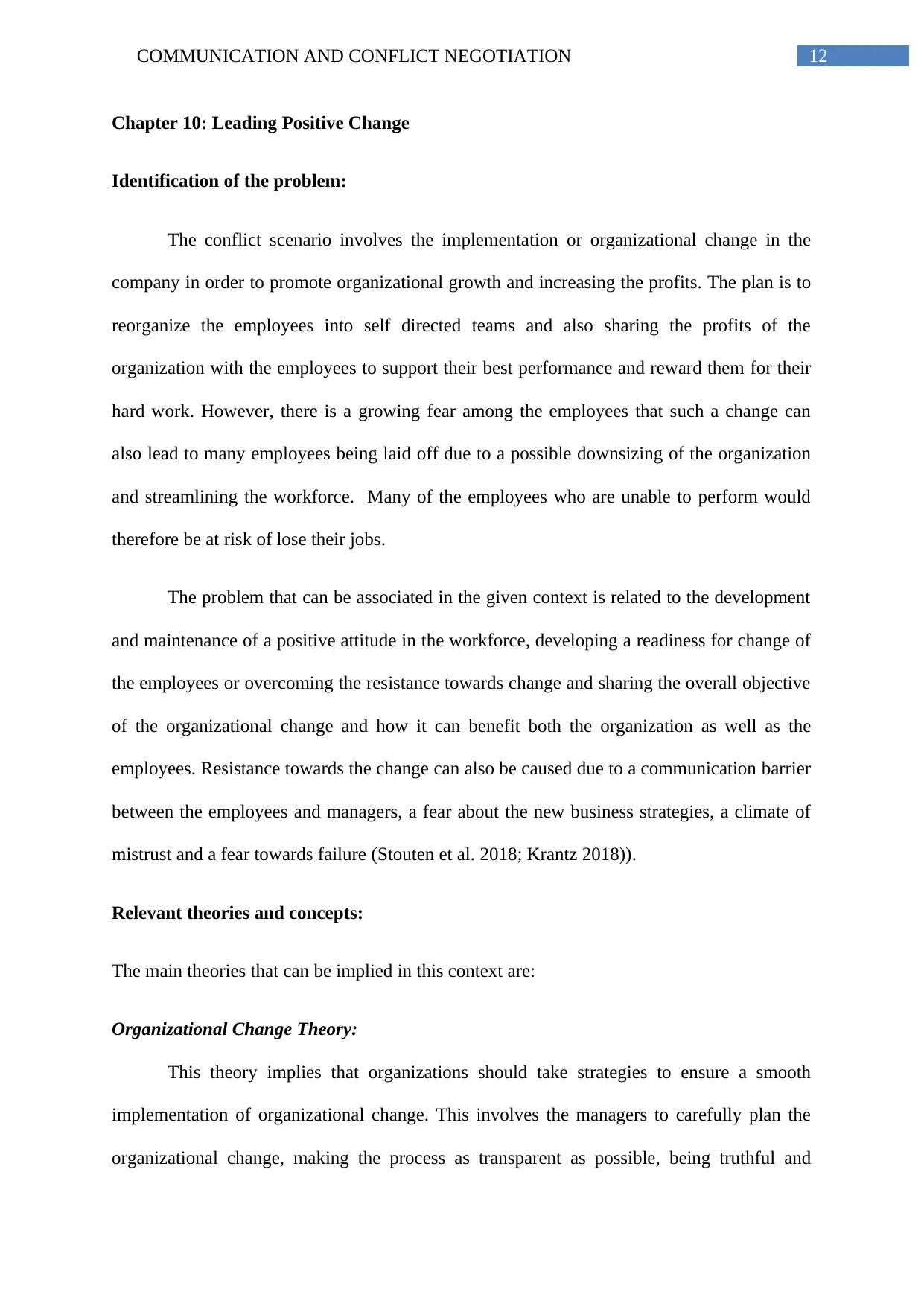
12COMMUNICATION AND CONFLICT NEGOTIATION
Chapter 10: Leading Positive Change
Identification of the problem:
The conflict scenario involves the implementation or organizational change in the
company in order to promote organizational growth and increasing the profits. The plan is to
reorganize the employees into self directed teams and also sharing the profits of the
organization with the employees to support their best performance and reward them for their
hard work. However, there is a growing fear among the employees that such a change can
also lead to many employees being laid off due to a possible downsizing of the organization
and streamlining the workforce. Many of the employees who are unable to perform would
therefore be at risk of lose their jobs.
The problem that can be associated in the given context is related to the development
and maintenance of a positive attitude in the workforce, developing a readiness for change of
the employees or overcoming the resistance towards change and sharing the overall objective
of the organizational change and how it can benefit both the organization as well as the
employees. Resistance towards the change can also be caused due to a communication barrier
between the employees and managers, a fear about the new business strategies, a climate of
mistrust and a fear towards failure (Stouten et al. 2018; Krantz 2018)).
Relevant theories and concepts:
The main theories that can be implied in this context are:
Organizational Change Theory:
This theory implies that organizations should take strategies to ensure a smooth
implementation of organizational change. This involves the managers to carefully plan the
organizational change, making the process as transparent as possible, being truthful and
Chapter 10: Leading Positive Change
Identification of the problem:
The conflict scenario involves the implementation or organizational change in the
company in order to promote organizational growth and increasing the profits. The plan is to
reorganize the employees into self directed teams and also sharing the profits of the
organization with the employees to support their best performance and reward them for their
hard work. However, there is a growing fear among the employees that such a change can
also lead to many employees being laid off due to a possible downsizing of the organization
and streamlining the workforce. Many of the employees who are unable to perform would
therefore be at risk of lose their jobs.
The problem that can be associated in the given context is related to the development
and maintenance of a positive attitude in the workforce, developing a readiness for change of
the employees or overcoming the resistance towards change and sharing the overall objective
of the organizational change and how it can benefit both the organization as well as the
employees. Resistance towards the change can also be caused due to a communication barrier
between the employees and managers, a fear about the new business strategies, a climate of
mistrust and a fear towards failure (Stouten et al. 2018; Krantz 2018)).
Relevant theories and concepts:
The main theories that can be implied in this context are:
Organizational Change Theory:
This theory implies that organizations should take strategies to ensure a smooth
implementation of organizational change. This involves the managers to carefully plan the
organizational change, making the process as transparent as possible, being truthful and
Paraphrase This Document
Need a fresh take? Get an instant paraphrase of this document with our AI Paraphraser

13COMMUNICATION AND CONFLICT NEGOTIATION
honest about the aims of the change process, involving effective communication strategies to
inform everyone about the need to change, developing a roadmap towards the process of
change, providing training for all employees to maintain the change, involve participation
from the employees in the change implementation process, avoiding the change to be
implemented in a hurry (not rushing in), monitoring and measuring the results and
implementing leadership in management (Hornstein 2015; Burke 2017).
Leadership Theory:
This theory implies that the management should act as leaders, leading other by their
examples and show everyone how the change can be beneficial to them. Effective leaders can
motivate the employees and orient them towards organizational goals. Moreover the
leadership can help to develop more participation from the employees in the process change,
and overcome resistance against it or increase readiness for change (Dinh et al. 2014).
Contemporary Theory of Conflict:
As discussed before, this theory supports that conflicts are a normal aspect in any
organization but however needs to be resolved. Thus the managers should not take up the
conflict as just a hurdle in their path, but a scope to learn about the perspectives of the
employees or to analyze the conflict situation, thereby increasing their own knowledge and
understanding (Ritzer and Stepnisky 2017).
Collaborated Style of Conflict management:
This style would allow a better collaboration between the conflicting parties, support
better coordination and communication and this help to implement the organizational change
management strategy in a more appropriate manner (Nesterkin et al. 2016; A. Way et al.
2014).
Analysis of the case:
honest about the aims of the change process, involving effective communication strategies to
inform everyone about the need to change, developing a roadmap towards the process of
change, providing training for all employees to maintain the change, involve participation
from the employees in the change implementation process, avoiding the change to be
implemented in a hurry (not rushing in), monitoring and measuring the results and
implementing leadership in management (Hornstein 2015; Burke 2017).
Leadership Theory:
This theory implies that the management should act as leaders, leading other by their
examples and show everyone how the change can be beneficial to them. Effective leaders can
motivate the employees and orient them towards organizational goals. Moreover the
leadership can help to develop more participation from the employees in the process change,
and overcome resistance against it or increase readiness for change (Dinh et al. 2014).
Contemporary Theory of Conflict:
As discussed before, this theory supports that conflicts are a normal aspect in any
organization but however needs to be resolved. Thus the managers should not take up the
conflict as just a hurdle in their path, but a scope to learn about the perspectives of the
employees or to analyze the conflict situation, thereby increasing their own knowledge and
understanding (Ritzer and Stepnisky 2017).
Collaborated Style of Conflict management:
This style would allow a better collaboration between the conflicting parties, support
better coordination and communication and this help to implement the organizational change
management strategy in a more appropriate manner (Nesterkin et al. 2016; A. Way et al.
2014).
Analysis of the case:
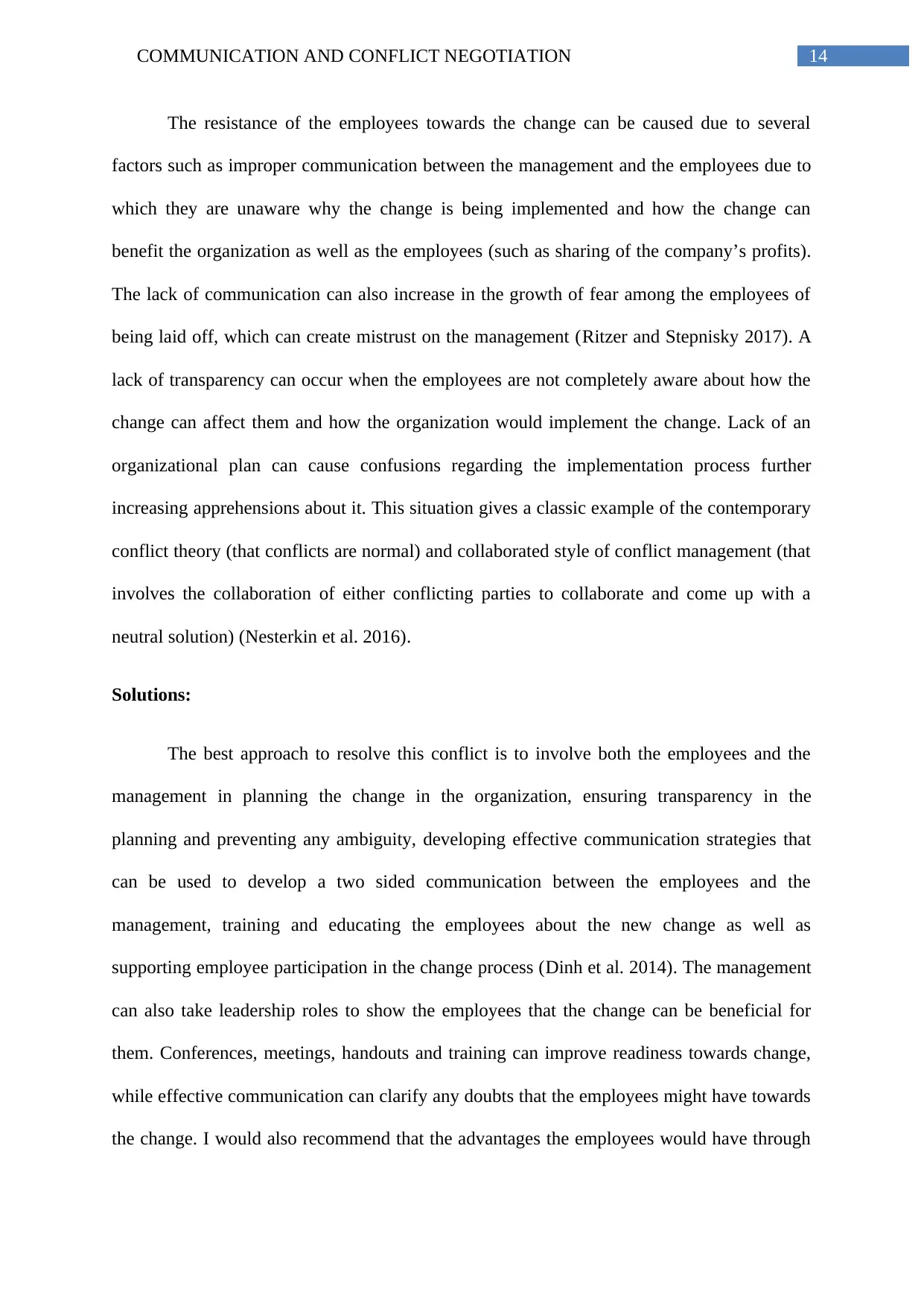
14COMMUNICATION AND CONFLICT NEGOTIATION
The resistance of the employees towards the change can be caused due to several
factors such as improper communication between the management and the employees due to
which they are unaware why the change is being implemented and how the change can
benefit the organization as well as the employees (such as sharing of the company’s profits).
The lack of communication can also increase in the growth of fear among the employees of
being laid off, which can create mistrust on the management (Ritzer and Stepnisky 2017). A
lack of transparency can occur when the employees are not completely aware about how the
change can affect them and how the organization would implement the change. Lack of an
organizational plan can cause confusions regarding the implementation process further
increasing apprehensions about it. This situation gives a classic example of the contemporary
conflict theory (that conflicts are normal) and collaborated style of conflict management (that
involves the collaboration of either conflicting parties to collaborate and come up with a
neutral solution) (Nesterkin et al. 2016).
Solutions:
The best approach to resolve this conflict is to involve both the employees and the
management in planning the change in the organization, ensuring transparency in the
planning and preventing any ambiguity, developing effective communication strategies that
can be used to develop a two sided communication between the employees and the
management, training and educating the employees about the new change as well as
supporting employee participation in the change process (Dinh et al. 2014). The management
can also take leadership roles to show the employees that the change can be beneficial for
them. Conferences, meetings, handouts and training can improve readiness towards change,
while effective communication can clarify any doubts that the employees might have towards
the change. I would also recommend that the advantages the employees would have through
The resistance of the employees towards the change can be caused due to several
factors such as improper communication between the management and the employees due to
which they are unaware why the change is being implemented and how the change can
benefit the organization as well as the employees (such as sharing of the company’s profits).
The lack of communication can also increase in the growth of fear among the employees of
being laid off, which can create mistrust on the management (Ritzer and Stepnisky 2017). A
lack of transparency can occur when the employees are not completely aware about how the
change can affect them and how the organization would implement the change. Lack of an
organizational plan can cause confusions regarding the implementation process further
increasing apprehensions about it. This situation gives a classic example of the contemporary
conflict theory (that conflicts are normal) and collaborated style of conflict management (that
involves the collaboration of either conflicting parties to collaborate and come up with a
neutral solution) (Nesterkin et al. 2016).
Solutions:
The best approach to resolve this conflict is to involve both the employees and the
management in planning the change in the organization, ensuring transparency in the
planning and preventing any ambiguity, developing effective communication strategies that
can be used to develop a two sided communication between the employees and the
management, training and educating the employees about the new change as well as
supporting employee participation in the change process (Dinh et al. 2014). The management
can also take leadership roles to show the employees that the change can be beneficial for
them. Conferences, meetings, handouts and training can improve readiness towards change,
while effective communication can clarify any doubts that the employees might have towards
the change. I would also recommend that the advantages the employees would have through
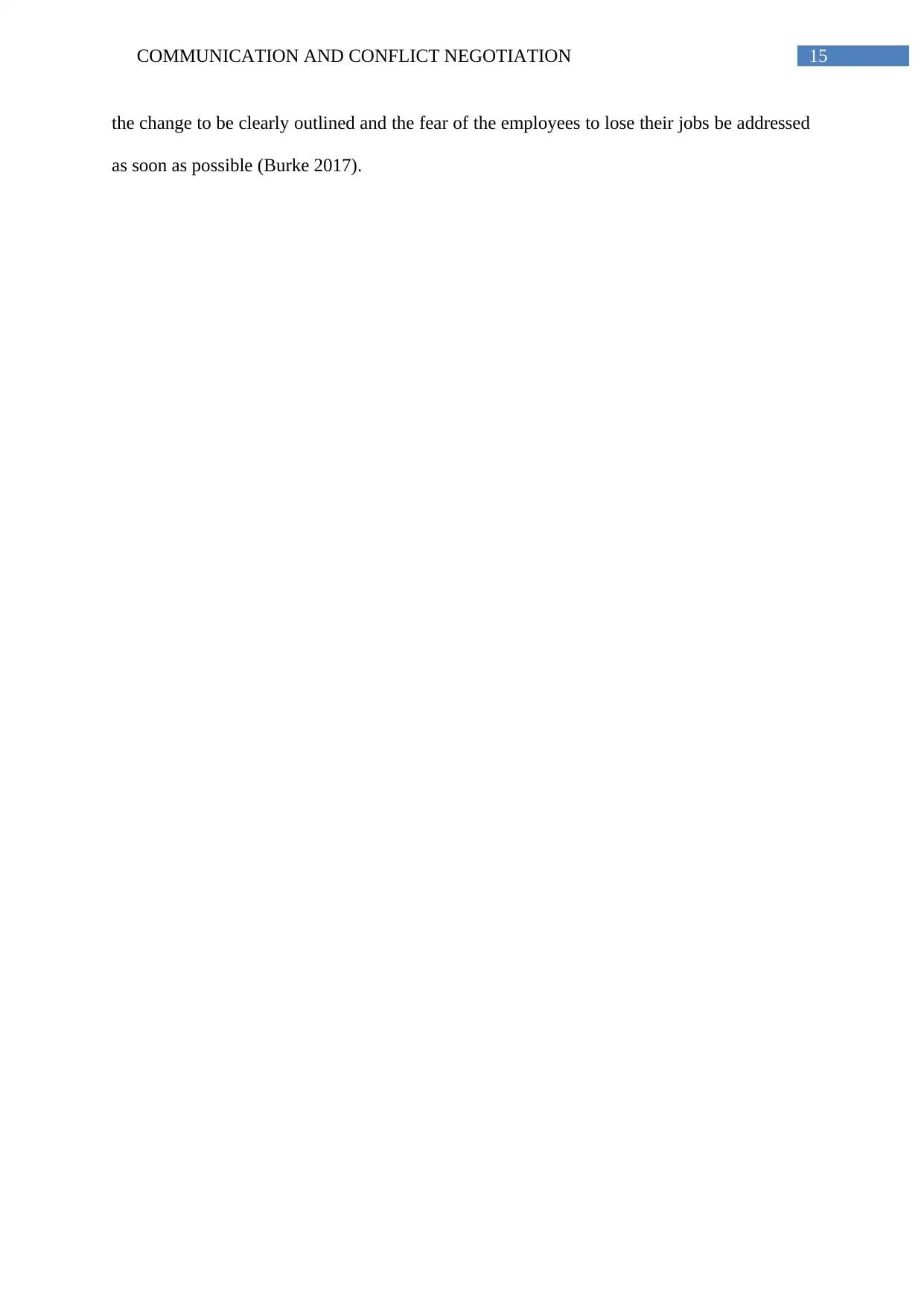
15COMMUNICATION AND CONFLICT NEGOTIATION
the change to be clearly outlined and the fear of the employees to lose their jobs be addressed
as soon as possible (Burke 2017).
the change to be clearly outlined and the fear of the employees to lose their jobs be addressed
as soon as possible (Burke 2017).
Secure Best Marks with AI Grader
Need help grading? Try our AI Grader for instant feedback on your assignments.
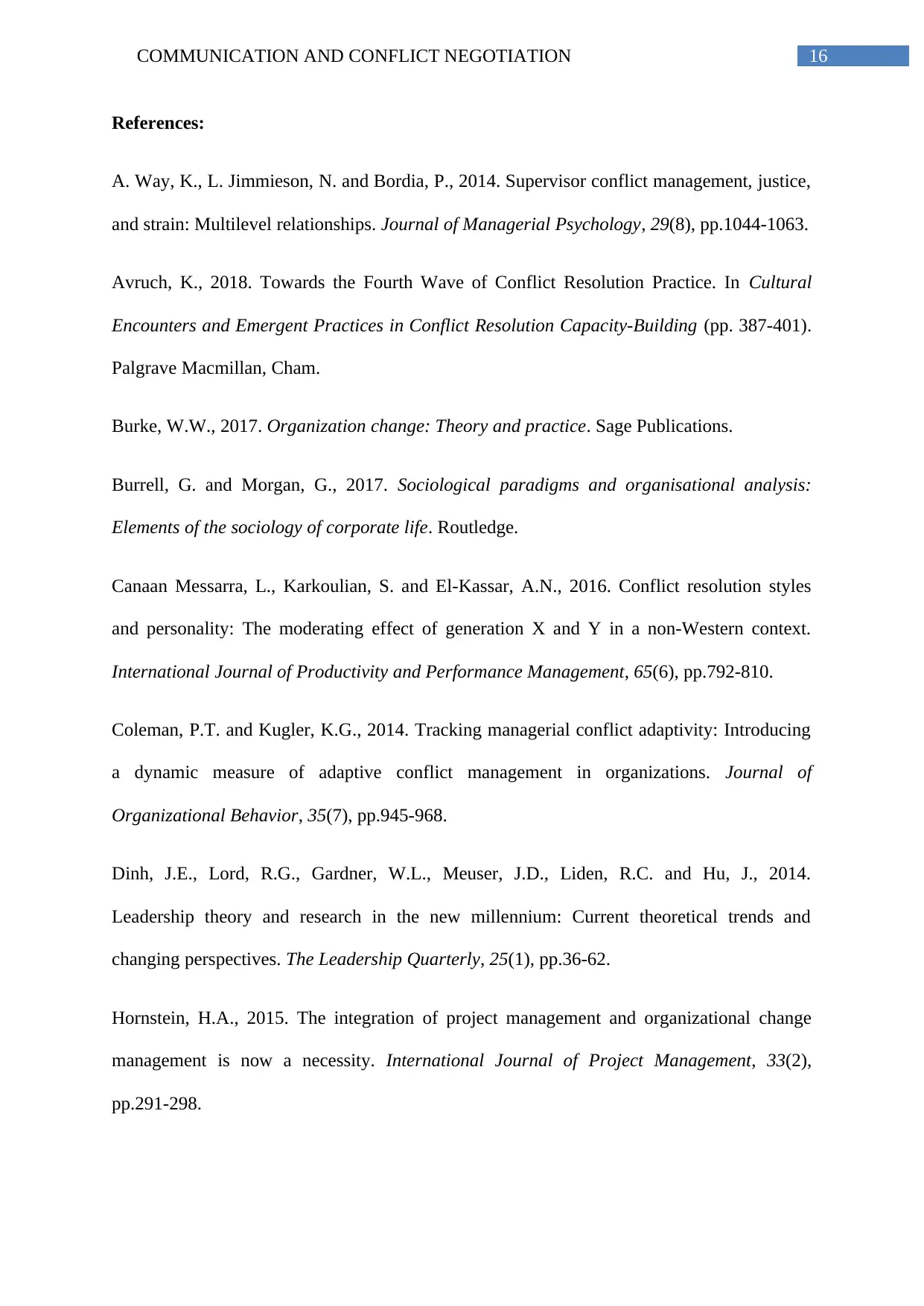
16COMMUNICATION AND CONFLICT NEGOTIATION
References:
A. Way, K., L. Jimmieson, N. and Bordia, P., 2014. Supervisor conflict management, justice,
and strain: Multilevel relationships. Journal of Managerial Psychology, 29(8), pp.1044-1063.
Avruch, K., 2018. Towards the Fourth Wave of Conflict Resolution Practice. In Cultural
Encounters and Emergent Practices in Conflict Resolution Capacity-Building (pp. 387-401).
Palgrave Macmillan, Cham.
Burke, W.W., 2017. Organization change: Theory and practice. Sage Publications.
Burrell, G. and Morgan, G., 2017. Sociological paradigms and organisational analysis:
Elements of the sociology of corporate life. Routledge.
Canaan Messarra, L., Karkoulian, S. and El-Kassar, A.N., 2016. Conflict resolution styles
and personality: The moderating effect of generation X and Y in a non-Western context.
International Journal of Productivity and Performance Management, 65(6), pp.792-810.
Coleman, P.T. and Kugler, K.G., 2014. Tracking managerial conflict adaptivity: Introducing
a dynamic measure of adaptive conflict management in organizations. Journal of
Organizational Behavior, 35(7), pp.945-968.
Dinh, J.E., Lord, R.G., Gardner, W.L., Meuser, J.D., Liden, R.C. and Hu, J., 2014.
Leadership theory and research in the new millennium: Current theoretical trends and
changing perspectives. The Leadership Quarterly, 25(1), pp.36-62.
Hornstein, H.A., 2015. The integration of project management and organizational change
management is now a necessity. International Journal of Project Management, 33(2),
pp.291-298.
References:
A. Way, K., L. Jimmieson, N. and Bordia, P., 2014. Supervisor conflict management, justice,
and strain: Multilevel relationships. Journal of Managerial Psychology, 29(8), pp.1044-1063.
Avruch, K., 2018. Towards the Fourth Wave of Conflict Resolution Practice. In Cultural
Encounters and Emergent Practices in Conflict Resolution Capacity-Building (pp. 387-401).
Palgrave Macmillan, Cham.
Burke, W.W., 2017. Organization change: Theory and practice. Sage Publications.
Burrell, G. and Morgan, G., 2017. Sociological paradigms and organisational analysis:
Elements of the sociology of corporate life. Routledge.
Canaan Messarra, L., Karkoulian, S. and El-Kassar, A.N., 2016. Conflict resolution styles
and personality: The moderating effect of generation X and Y in a non-Western context.
International Journal of Productivity and Performance Management, 65(6), pp.792-810.
Coleman, P.T. and Kugler, K.G., 2014. Tracking managerial conflict adaptivity: Introducing
a dynamic measure of adaptive conflict management in organizations. Journal of
Organizational Behavior, 35(7), pp.945-968.
Dinh, J.E., Lord, R.G., Gardner, W.L., Meuser, J.D., Liden, R.C. and Hu, J., 2014.
Leadership theory and research in the new millennium: Current theoretical trends and
changing perspectives. The Leadership Quarterly, 25(1), pp.36-62.
Hornstein, H.A., 2015. The integration of project management and organizational change
management is now a necessity. International Journal of Project Management, 33(2),
pp.291-298.
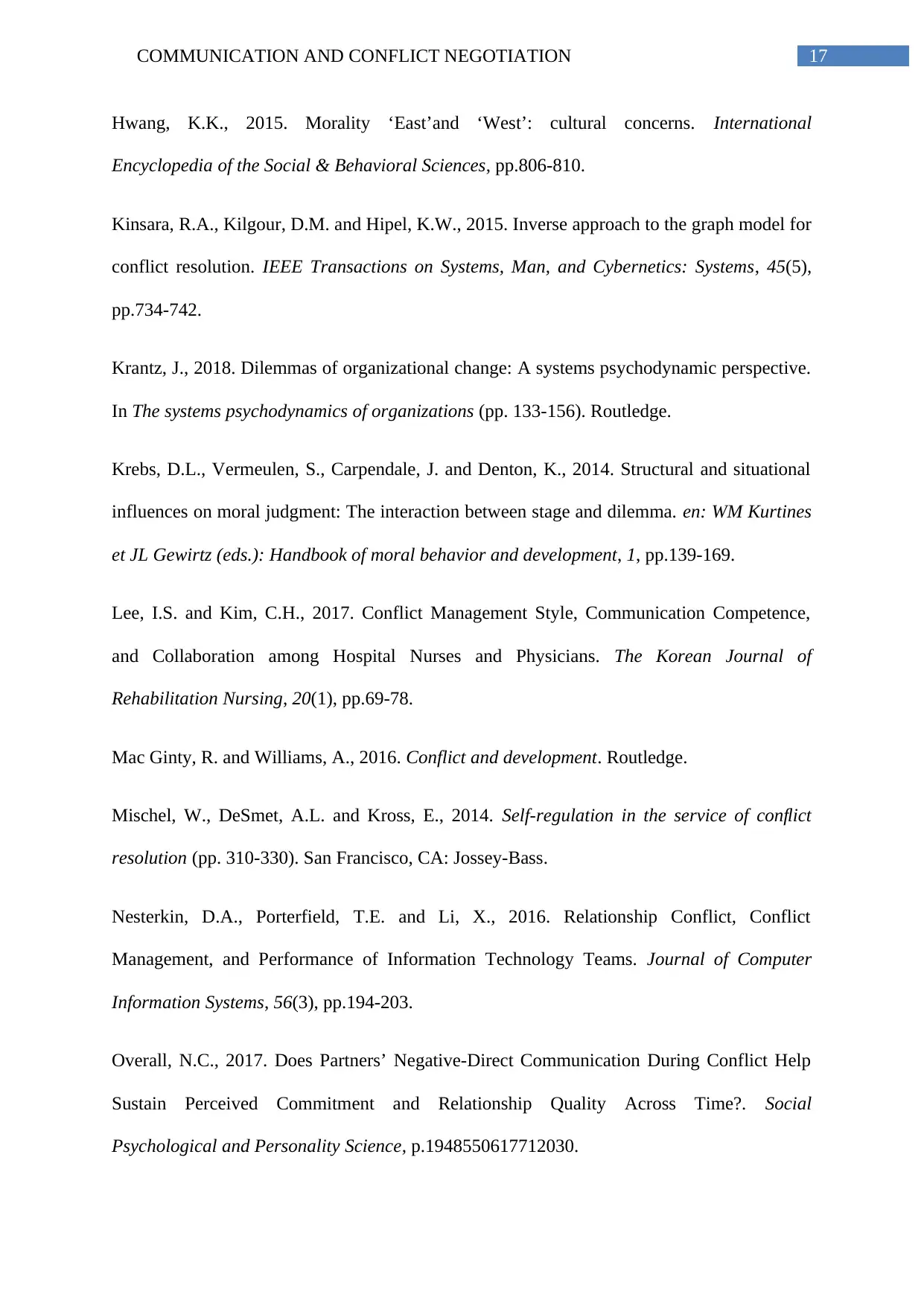
17COMMUNICATION AND CONFLICT NEGOTIATION
Hwang, K.K., 2015. Morality ‘East’and ‘West’: cultural concerns. International
Encyclopedia of the Social & Behavioral Sciences, pp.806-810.
Kinsara, R.A., Kilgour, D.M. and Hipel, K.W., 2015. Inverse approach to the graph model for
conflict resolution. IEEE Transactions on Systems, Man, and Cybernetics: Systems, 45(5),
pp.734-742.
Krantz, J., 2018. Dilemmas of organizational change: A systems psychodynamic perspective.
In The systems psychodynamics of organizations (pp. 133-156). Routledge.
Krebs, D.L., Vermeulen, S., Carpendale, J. and Denton, K., 2014. Structural and situational
influences on moral judgment: The interaction between stage and dilemma. en: WM Kurtines
et JL Gewirtz (eds.): Handbook of moral behavior and development, 1, pp.139-169.
Lee, I.S. and Kim, C.H., 2017. Conflict Management Style, Communication Competence,
and Collaboration among Hospital Nurses and Physicians. The Korean Journal of
Rehabilitation Nursing, 20(1), pp.69-78.
Mac Ginty, R. and Williams, A., 2016. Conflict and development. Routledge.
Mischel, W., DeSmet, A.L. and Kross, E., 2014. Self-regulation in the service of conflict
resolution (pp. 310-330). San Francisco, CA: Jossey-Bass.
Nesterkin, D.A., Porterfield, T.E. and Li, X., 2016. Relationship Conflict, Conflict
Management, and Performance of Information Technology Teams. Journal of Computer
Information Systems, 56(3), pp.194-203.
Overall, N.C., 2017. Does Partners’ Negative-Direct Communication During Conflict Help
Sustain Perceived Commitment and Relationship Quality Across Time?. Social
Psychological and Personality Science, p.1948550617712030.
Hwang, K.K., 2015. Morality ‘East’and ‘West’: cultural concerns. International
Encyclopedia of the Social & Behavioral Sciences, pp.806-810.
Kinsara, R.A., Kilgour, D.M. and Hipel, K.W., 2015. Inverse approach to the graph model for
conflict resolution. IEEE Transactions on Systems, Man, and Cybernetics: Systems, 45(5),
pp.734-742.
Krantz, J., 2018. Dilemmas of organizational change: A systems psychodynamic perspective.
In The systems psychodynamics of organizations (pp. 133-156). Routledge.
Krebs, D.L., Vermeulen, S., Carpendale, J. and Denton, K., 2014. Structural and situational
influences on moral judgment: The interaction between stage and dilemma. en: WM Kurtines
et JL Gewirtz (eds.): Handbook of moral behavior and development, 1, pp.139-169.
Lee, I.S. and Kim, C.H., 2017. Conflict Management Style, Communication Competence,
and Collaboration among Hospital Nurses and Physicians. The Korean Journal of
Rehabilitation Nursing, 20(1), pp.69-78.
Mac Ginty, R. and Williams, A., 2016. Conflict and development. Routledge.
Mischel, W., DeSmet, A.L. and Kross, E., 2014. Self-regulation in the service of conflict
resolution (pp. 310-330). San Francisco, CA: Jossey-Bass.
Nesterkin, D.A., Porterfield, T.E. and Li, X., 2016. Relationship Conflict, Conflict
Management, and Performance of Information Technology Teams. Journal of Computer
Information Systems, 56(3), pp.194-203.
Overall, N.C., 2017. Does Partners’ Negative-Direct Communication During Conflict Help
Sustain Perceived Commitment and Relationship Quality Across Time?. Social
Psychological and Personality Science, p.1948550617712030.
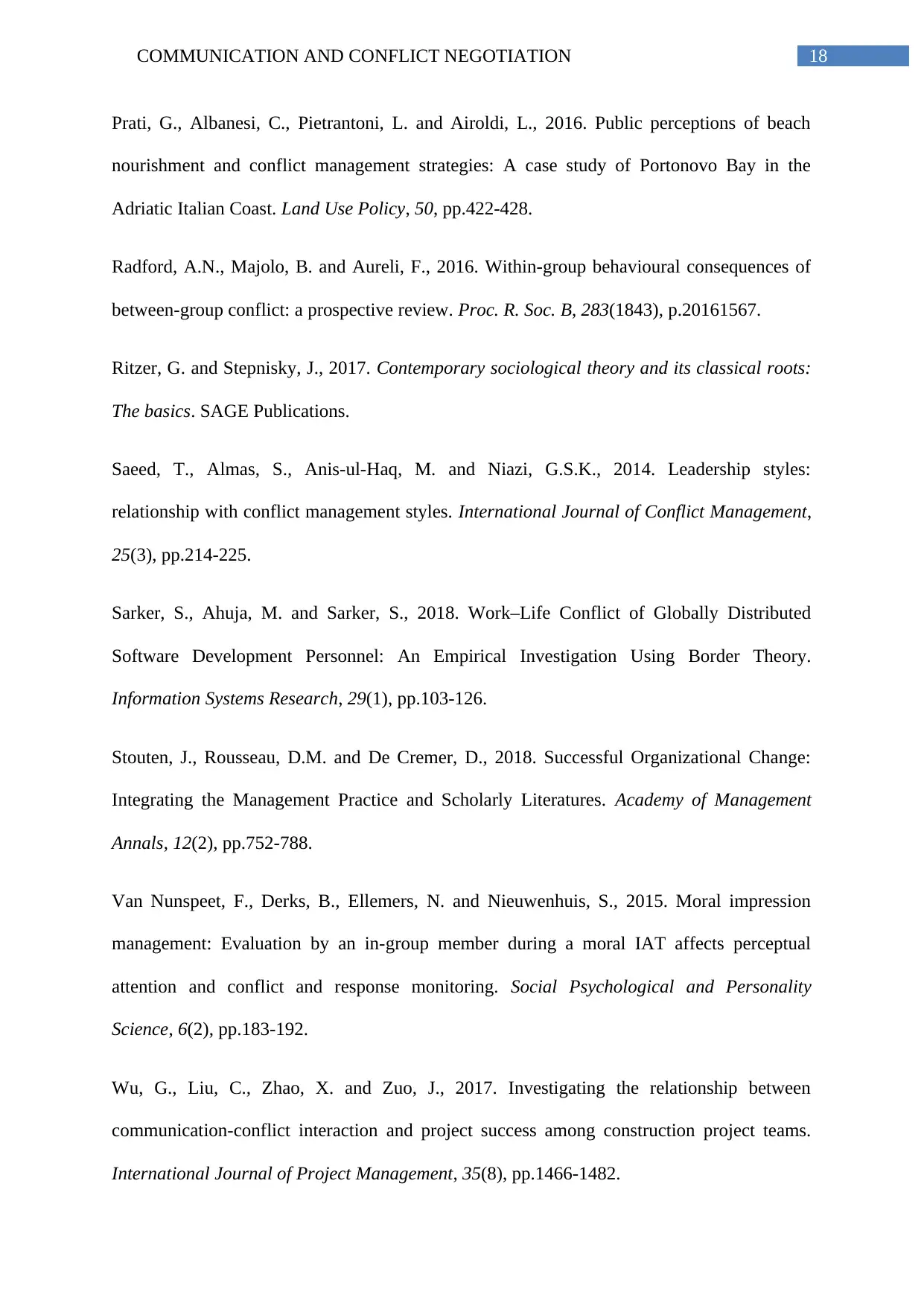
18COMMUNICATION AND CONFLICT NEGOTIATION
Prati, G., Albanesi, C., Pietrantoni, L. and Airoldi, L., 2016. Public perceptions of beach
nourishment and conflict management strategies: A case study of Portonovo Bay in the
Adriatic Italian Coast. Land Use Policy, 50, pp.422-428.
Radford, A.N., Majolo, B. and Aureli, F., 2016. Within-group behavioural consequences of
between-group conflict: a prospective review. Proc. R. Soc. B, 283(1843), p.20161567.
Ritzer, G. and Stepnisky, J., 2017. Contemporary sociological theory and its classical roots:
The basics. SAGE Publications.
Saeed, T., Almas, S., Anis-ul-Haq, M. and Niazi, G.S.K., 2014. Leadership styles:
relationship with conflict management styles. International Journal of Conflict Management,
25(3), pp.214-225.
Sarker, S., Ahuja, M. and Sarker, S., 2018. Work–Life Conflict of Globally Distributed
Software Development Personnel: An Empirical Investigation Using Border Theory.
Information Systems Research, 29(1), pp.103-126.
Stouten, J., Rousseau, D.M. and De Cremer, D., 2018. Successful Organizational Change:
Integrating the Management Practice and Scholarly Literatures. Academy of Management
Annals, 12(2), pp.752-788.
Van Nunspeet, F., Derks, B., Ellemers, N. and Nieuwenhuis, S., 2015. Moral impression
management: Evaluation by an in-group member during a moral IAT affects perceptual
attention and conflict and response monitoring. Social Psychological and Personality
Science, 6(2), pp.183-192.
Wu, G., Liu, C., Zhao, X. and Zuo, J., 2017. Investigating the relationship between
communication-conflict interaction and project success among construction project teams.
International Journal of Project Management, 35(8), pp.1466-1482.
Prati, G., Albanesi, C., Pietrantoni, L. and Airoldi, L., 2016. Public perceptions of beach
nourishment and conflict management strategies: A case study of Portonovo Bay in the
Adriatic Italian Coast. Land Use Policy, 50, pp.422-428.
Radford, A.N., Majolo, B. and Aureli, F., 2016. Within-group behavioural consequences of
between-group conflict: a prospective review. Proc. R. Soc. B, 283(1843), p.20161567.
Ritzer, G. and Stepnisky, J., 2017. Contemporary sociological theory and its classical roots:
The basics. SAGE Publications.
Saeed, T., Almas, S., Anis-ul-Haq, M. and Niazi, G.S.K., 2014. Leadership styles:
relationship with conflict management styles. International Journal of Conflict Management,
25(3), pp.214-225.
Sarker, S., Ahuja, M. and Sarker, S., 2018. Work–Life Conflict of Globally Distributed
Software Development Personnel: An Empirical Investigation Using Border Theory.
Information Systems Research, 29(1), pp.103-126.
Stouten, J., Rousseau, D.M. and De Cremer, D., 2018. Successful Organizational Change:
Integrating the Management Practice and Scholarly Literatures. Academy of Management
Annals, 12(2), pp.752-788.
Van Nunspeet, F., Derks, B., Ellemers, N. and Nieuwenhuis, S., 2015. Moral impression
management: Evaluation by an in-group member during a moral IAT affects perceptual
attention and conflict and response monitoring. Social Psychological and Personality
Science, 6(2), pp.183-192.
Wu, G., Liu, C., Zhao, X. and Zuo, J., 2017. Investigating the relationship between
communication-conflict interaction and project success among construction project teams.
International Journal of Project Management, 35(8), pp.1466-1482.
Paraphrase This Document
Need a fresh take? Get an instant paraphrase of this document with our AI Paraphraser
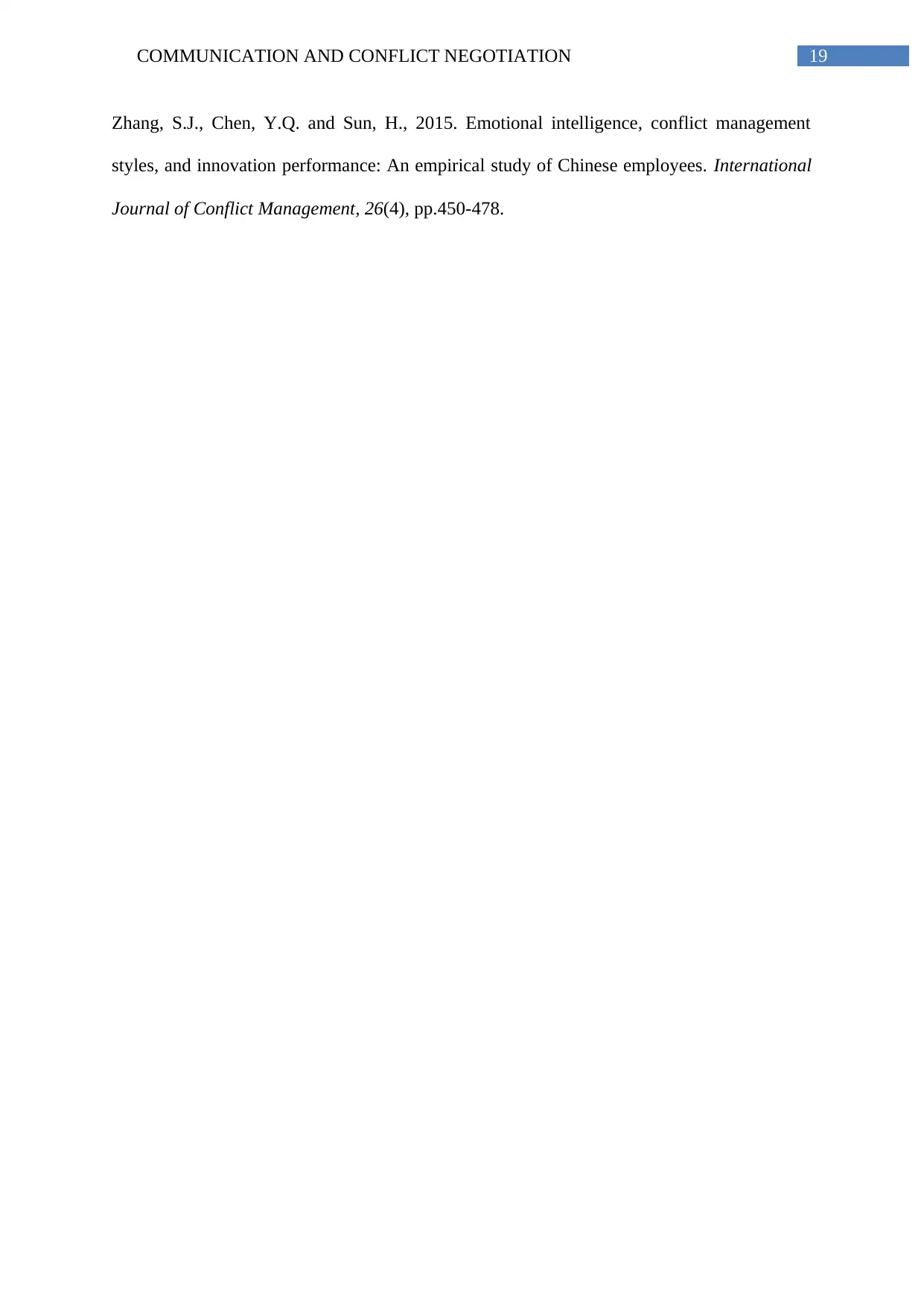
19COMMUNICATION AND CONFLICT NEGOTIATION
Zhang, S.J., Chen, Y.Q. and Sun, H., 2015. Emotional intelligence, conflict management
styles, and innovation performance: An empirical study of Chinese employees. International
Journal of Conflict Management, 26(4), pp.450-478.
Zhang, S.J., Chen, Y.Q. and Sun, H., 2015. Emotional intelligence, conflict management
styles, and innovation performance: An empirical study of Chinese employees. International
Journal of Conflict Management, 26(4), pp.450-478.
1 out of 20
Related Documents
Your All-in-One AI-Powered Toolkit for Academic Success.
+13062052269
info@desklib.com
Available 24*7 on WhatsApp / Email
![[object Object]](/_next/static/media/star-bottom.7253800d.svg)
Unlock your academic potential
© 2024 | Zucol Services PVT LTD | All rights reserved.





